Lean Six Sigma Training Certification
- Facebook Instagram Twitter LinkedIn YouTube
- (877) 497-4462


Lean Leadership: Principles, Practices & Future of Operational Excellence
April 5th, 2024
With 20+ experience in the field I have learned continuous improvement is crucial to staying ahead of the competition, and lean leadership serves as the driving force behind this relentless pursuit of excellence.
Lean leadership is a philosophy that empowers organizations to meet their full potential by fostering a culture of respect, collaboration, and continuous learning.
It is a mindset that transcends traditional command-and-control hierarchies, encouraging leaders to serve as mentors, coaches, and facilitators rather than mere authority figures.
By connecting with the front line, understanding the processes intimately, and empowering teams to identify and eliminate waste , lean leaders pave the way for sustainable growth and operational excellence.
From manufacturing powerhouses like Toyota, where the principles of lean originated , to the dynamic world of healthcare and service-oriented businesses, the impact of lean leadership has been nothing short of remarkable.
Key Highlights
Learning the core principles and practices of lean leadership:
- The lean leadership philosophy, rooted in the Toyota Production System , emphasizes respect for people
- The significance of gemba walks, which enable leaders to connect with the front line.
- The multifaceted roles and responsibilities of lean leaders, include coaching and developing teams, fostering problem-solving skills through kaizen events , and A3 problem-solving
- Real-world success stories, such as Toyota’s lean journey, showcasing the application of lean thinking
- Pathways for developing lean leadership capabilities through targeted training, Gemba coaching, lean certifications, and continuous improvement events.
- The future of lean leadership in the digital age.
The importance of embracing a lean leadership mindset focused on customer centricity, operational excellence, innovation, and continuous learning to drive long-term success.
Principles of Lean Leadership: Driving Continuous Improvement
At the very heart of lean leadership lies a profound understanding that continuous improvement is not merely a tool or methodology, but a way of life – a relentless pursuit of excellence that permeates every aspect of an organization.
This philosophy, born from the pioneering work of Toyota and its celebrated Toyota Production System (TPS), has revolutionized the way businesses approach operational excellence , forever changing the landscape of modern management.
Lean Leadership Philosophy
Toyota Production System
The Toyota Production System, often regarded as the birthplace of lean principles, is a comprehensive management approach that emphasizes the elimination of waste, respect for people, and a never-ending quest for perfection.
Developed over decades of trial and error, the TPS laid the foundation for what we now recognize as lean leadership, instilling a culture of continuous improvement and problem-solving at every level of the organization.
Respect People
One of the pillars of lean leadership is the unwavering respect for people – a deep appreciation for the inherent value and potential of every individual within the organization.
This principle recognizes that true improvement can only be achieved when employees are empowered, engaged, and given the autonomy to contribute their insights and expertise.
Servant Leadership
Contrary to traditional top-down leadership models, lean leaders embrace the concept of servant leadership, where their primary role is to serve and support their teams.
Rather than dictating from ivory towers, lean leaders roll up their sleeves and immerse themselves in the gemba (the actual place where work is done), actively listening to the frontline employees and providing the resources and guidance they need to succeed.
Continuous Improvement Mindset
At the core of lean leadership is a relentless drive for continuous improvement, or kaizen – the belief that no process is ever truly perfect and that there is always room for optimization and growth.
This mindset encourages leaders to embrace a beginner’s mind, remaining open to new ideas and perspectives, and fostering a culture of learning and experimentation.
By encouraging small, incremental changes and celebrating even the most modest improvements, lean leaders create an environment where innovation thrives, and complacency is never an option.
Gemba Walk: Connecting with the Frontline
One of the fundamental practices of lean leadership is the gemba walk , which embodies the principle of “go and see” – a conscious effort to leave the comfort of the boardroom and venture into the actual workplace, where the real action happens.
By physically observing processes in action, lean leaders gain invaluable insights into the challenges, constraints, and opportunities that exist on the front lines, enabling them to make informed decisions and implement targeted improvements.
Genchi Genbutsu
Closely related to the “go and see” principle is the concept of genchi genbutsu , which translates to “go and see for yourself”.
This philosophy emphasizes the importance of direct observation and firsthand experience, encouraging lean leaders to immerse themselves in the Gemba and witness the realities of the work environment with their own eyes.
By doing so, they can better understand the nuances of the processes, identify potential areas of waste or inefficiency, and collaborate with frontline employees to develop practical solutions.
Value Stream Mapping
A powerful tool in the lean leader’s arsenal is value stream mapping , a visual technique that allows organizations to map out the flow of materials and information throughout their entire value chain.
By creating a comprehensive picture of the current state, lean leaders can identify bottlenecks, redundancies, and non-value-added activities, paving the way for streamlined processes and improved efficiency.
Value stream mapping also serves as a collaborative exercise, fostering cross-functional communication and alignment among teams.
Understand Processes
Underpinning the lean leadership philosophy is a deep commitment to understanding processes – not just on a surface level, but in their entirety, from start to finish.
By truly comprehending the intricacies and interdependencies of each process, lean leaders can make informed decisions, identify opportunities for improvement, and implement targeted solutions that drive measurable results.
This level of process understanding also enables leaders to effectively mentor and coach their teams, empowering them with the knowledge and tools they need to drive continuous improvement from within.
Lean Leader Roles and Responsibilities
While the principles of lean leadership may seem inherently simple, their effective implementation requires a multifaceted approach and a profound understanding of the various roles and responsibilities that lean leaders must embrace.
Coaching and Developing Teams
One of the core responsibilities of a lean leader is to serve as a mentor, guiding and supporting their teams through the often-challenging journey of process optimization and cultural transformation.
Problem-Solving Skills
At the heart of lean leadership lies a relentless pursuit of problem-solving excellence. Lean leaders must equip their teams with the necessary tools and techniques to identify, analyze, and address the root causes of inefficiencies and waste.
This involves cultivating a culture of critical thinking, encouraging employees to challenge assumptions, and providing them with the resources and training they need to develop robust problem-solving skills.
Kaizen Events
One powerful approach to fostering a problem-solving mindset is through the implementation of kaizen events – focused, collaborative sessions where cross-functional teams come together to address specific challenges or opportunities for improvement.
These events not only provide a structured framework for problem-solving but also serve as a platform for knowledge sharing, team building, and fostering a sense of shared ownership.
A3 Problem Solving
Another invaluable tool in the lean leader’s toolkit is the A3 problem-solving methodology .
This structured approach, which takes its name from the size of the paper used, provides a concise and visual framework for documenting and communicating the problem-solving process.
Building a Lean Culture
Employee Empowerment
At the core of lean leadership lies a fundamental belief in the power of employee empowerment.
Lean leaders understand that true transformation can only be achieved when individuals at every level of the organization are given the autonomy, resources, and support they need to drive change.
Teamwork and Collaboration
Lean leadership recognizes that the path to excellence is rarely a solo journey.
Instead, it relies heavily on the principles of teamwork and collaboration, where individuals from diverse backgrounds and perspectives come together to tackle complex challenges.
This not only enhances problem-solving capabilities but also promotes a sense of unity and shared purpose, driving the organization toward its common goals.
Visual Management
Effective communication is a cornerstone of lean leadership, and visual management plays a crucial role in this endeavor.
By implementing visual tools and techniques, such as performance boards, kanban systems, and value stream maps, lean leaders can create a shared understanding of processes, goals, and performance metrics across the entire organization.
Standard Work
Standardization is a fundamental principle of lean leadership, as it provides a solid foundation upon which continuous improvement can be built.
By establishing standard work procedures and protocols, lean leaders can ensure consistency, reduce variability , and create a baseline for future improvements.
Lean Leadership in Practice: Real-World Examples
While the principles and practices of lean leadership may seem straightforward in theory, their true power lies in their practical application across a diverse range of industries and organizations.
From Toyota, where lean thinking originated, to the cutting-edge world of healthcare and service sectors, lean leadership has proven its ability to drive transformative change and unlock new levels of operational excellence.
Toyota’s Lean Success Story
Lean Thinking
No discussion of lean leadership would be complete without exploring the pioneering work of Toyota, the company that gave birth to the lean philosophy.
At the heart of Toyota’s success lies a profound commitment to lean thinking – a holistic approach that encompasses not only the elimination of waste but also a deep respect for people and a relentless pursuit of perfection.
Just-in-Time Production
One of the cornerstone principles of Toyota’s lean revolution is the just-in-time (JIT) production system.
By synchronizing the flow of materials and components with customer demand, Toyota was able to minimize excess inventory, reduce lead times, and drive significant cost savings.
However, the true power of JIT extends far beyond mere inventory management – it represents a fundamental shift in mindset, challenging traditional notions of mass production and embracing a more agile, responsive approach to manufacturing .
Complementing the JIT system is the principle of jidoka , or “autonomation”, which empowers machines and processes to detect and prevent defects or abnormalities, effectively “stopping the line” when necessary.
This philosophy not only promotes quality control but also fosters a culture of respect for people, as it relieves workers from the burden of constant monitoring and allows them to focus on higher-value tasks.
Hoshin Kanri
Underpinning Toyota’s lean success is the practice of hoshin kanri , or policy deployment – a systematic approach to cascading strategic objectives throughout the organization.
Through this process, Toyota ensures that every level of the company, from the executive suite to the front line, is aligned and working towards the same goals.
Lean Transformations Across Industries
Manufacturing Lean
While Toyota may have pioneered the lean revolution, the principles of lean leadership have since transcended the boundaries of the automotive industry, finding a home in a wide range of manufacturing sectors.
From aerospace and electronics to consumer goods and heavy machinery, companies around the world have embraced lean practices to streamline their operations, reduce waste, and enhance their competitiveness.
Service Sector Lean
In recent years, the transformative power of lean leadership has extended far beyond traditional manufacturing, permeating the dynamic world of service industries.
From financial institutions and healthcare providers to hospitality and retail operations, companies across the service sector have recognized the immense potential of lean principles to enhance customer experiences, optimize processes , and drive operational excellence.
Healthcare Lean
One industry that has embraced lean leadership with particularly impressive results in healthcare.
By applying lean principles to complex medical processes, healthcare organizations have been able to reduce waste, improve patient safety, and enhance the overall quality of care.
From optimizing patient flow and reducing medication errors to streamlining administrative tasks and enhancing supply chain management, lean leadership has proven to be a powerful catalyst for transformation in this critically important sector.
Lean Office and Administrative Processes
Lean leadership is not limited to the realms of manufacturing and service delivery; its principles have also proven invaluable in optimizing office and administrative processes.
Developing Lean Leadership Capabilities
As we’ve explored, the principles of lean leadership are deceptively simple yet profoundly transformative.
However, the journey toward mastering this philosophy and embedding it into the fabric of an organization requires unwavering commitment, continuous learning, and a willingness to confront and overcome the inevitable obstacles that arise along the way.
It is a path that demands not only a deep understanding of lean methodologies but also a cultivation of the essential leadership qualities that will enable true cultural change.
Training and Learning Pathways
Lean Leadership Courses
For those embarking on the lean leadership journey, a comprehensive education is often the first step.
Fortunately, a wealth of lean leadership courses and programs are available, offering a structured curriculum that covers the foundational principles, tools, and methodologies of this powerful management philosophy.
Gemba Coaching
However, no amount of classroom learning can truly replace the invaluable experience of Gemba coaching – the art of guiding and mentoring leaders in the actual workplace, where lean principles are put into action.
Through structured Gemba walks and one-on-one coaching sessions, experienced lean practitioners can impart their wisdom, provide real-time feedback, and help leaders develop the critical thinking and problem-solving skills necessary to drive continuous improvement.
This immersive approach not only reinforces the theoretical knowledge but also cultivates a deeper appreciation for the nuances and complexities of lean leadership in practice.
Lean Certifications
For those seeking to validate their lean leadership capabilities and demonstrate their commitment to the philosophy, a wide range of lean certifications are available.
From entry-level certifications like Lean Six Sigma Green Belt to advanced designations like Lean Master Black Belt , these credentials serve as a testament to an individual’s mastery of lean principles and methodologies.
Continuous Improvement Events
Complementing formal training and certification programs are continuous improvement events, which provide a dynamic and collaborative platform for lean leaders to hone their skills and drive tangible results.
These structured events, often referred to as kaizen events or rapid improvement events, bring together cross-functional teams to tackle specific process challenges or opportunities for optimization.
Overcoming Challenges and Obstacles
Change Management
Despite the countless success stories and proven benefits of lean leadership, the path to transformation is rarely a smooth one.
One of the most significant challenges that lean leaders must confront is the inherent resistance to change that often permeates organizations.
Whether rooted in fear of the unknown, ingrained cultural norms, or a lack of understanding, this resistance can manifest in various forms, from passive skepticism to outright opposition.
To overcome this obstacle, lean leaders must become adept at change management , employing effective communication strategies, fostering a culture of trust and transparency, and demonstrating unwavering commitment to the lean philosophy.
Resistance to Change
Closely tied to the challenge of change management is the ever-present resistance to change itself.
Even in organizations where the benefits of lean leadership are widely acknowledged, there will inevitably be pockets of resistance – individuals or groups who cling to the status quo, unwilling or unable to embrace the new ways of thinking and working that lean principles demand.
In such cases, lean leaders must exercise patience, empathy, and perseverance, recognizing that sustainable change is a journey, not a destination.
Leadership Commitment
Perhaps the greatest obstacle to successful lean leadership, however, is a lack of genuine commitment from the organization’s leadership team.
Without unwavering buy-in and visible support from those at the top, even the most well-intentioned lean initiatives are likely to falter and ultimately fail.
Lean leaders must therefore be tireless champions of the lean philosophy, consistently demonstrating their commitment through their actions, decisions, and allocation of resources.
Sustaining Lean Culture
Finally, the ultimate test lies in sustaining the lean culture over the long term. Complacency, shifting priorities, and a gradual erosion of lean practices can all threaten the hard-won gains achieved through lean leadership.
To combat this, lean leaders must remain vigilant, continuously reinforcing the lean mindset through ongoing training, coaching, and recognition programs.
They must also be proactive in identifying and addressing any emerging signs of backsliding, taking swift action to course-correct and maintain the momentum of continuous improvement .
The Future of Lean Leadership
As we stand on the precipice of a new era, defined by rapid technological advancements, shifting global dynamics, and ever-evolving customer expectations, the role of lean leadership is poised to become more crucial than ever before.
To remain competitive in this race, companies must not only use the core principles of lean but also adapt and grow, integrating these time-honored philosophies with the latest innovations and paradigm shifts.
Perhaps one of the most profound impacts of the digital age on lean leadership is the unprecedented access to data and the ability to leverage advanced analytics for data-driven decision-making.
Above all, the lean leaders of the future must embrace a relentless commitment to continuous learning. As the pace of change accelerates and the competitive landscape evolves, the ability to adapt, unlearn, and relearn will be paramount.
Lean leaders must cultivate a growth mindset, both within themselves and their teams, fostering a culture of intellectual curiosity, open-mindedness, and a willingness to challenge assumptions.
SixSigma.us offers both Live Virtual classes as well as Online Self-Paced training. Most option includes access to the same great Master Black Belt instructors that teach our World Class in-person sessions. Sign-up today!
Virtual Classroom Training Programs Self-Paced Online Training Programs
SixSigma.us Accreditation & Affiliations

Monthly Management Tips
- Be the first one to receive the latest updates and information from 6Sigma
- Get curated resources from industry-experts
- Gain an edge with complete guides and other exclusive materials
- Become a part of one of the largest Six Sigma community
- Unlock your path to become a Six Sigma professional
" * " indicates required fields

Lean,Lean Training,Successful Managers
What is Lean Leadership: How To Become a Lean Leader
September 26, 2023 by Joe Aherne
As industries, businesses, and sectors change in our fast-paced world, leadership must take on new meanings. Leaders must adapt using different techniques to guide operations in the right direction. This is where Lean leadership comes into play.
Lean leadership is a mindset and practice that can transform organizational processes. In this article, we’ll dive into Lean leadership principles and provide you with actionable steps to become someone who can drive efficiency, innovation, and sustainable success within your team.
Table of Contents
What is Lean Leadership?
Why do you need lean leadership, skills of lean managers, habits of lean managers, how to develop a lean leader in your organization, final thoughts on lean leadership.
Lean leadership is an approach rooted in the principles of Lean methodology . At its core, it aims to reduce wasteful processes, streamline operations, and consistently improve organizational performance.
A Lean leader is not just a manager but a catalyst for positive change within their team or business. They prioritize the following fundamental principles:
- Value-Centric Approaches: Lean leaders focus on delivering value to customers by identifying and eliminating activities that don’t contribute to that goal. This helps in resource optimization and customer satisfaction.
- Continuous Improvement: Lean leaders encourage all team members to seek better ways of doing things and participate in regular reflection.
- Respect for People: These leaders understand the value of their team. They respect their ideas, support their contributions, and foster their growth.
- Gemba Walks: Lean leaders frequently visit the “Gemba,” or the place where work happens, to gain a firsthand understanding of processes and challenges.
- Lead by Example: Good Lean leadership demonstrates the behaviours and mindset expected of team members.
“The reality is that the only way change comes is when you lead by example.” — Anne Wojcicki, CEO of 23andMe.
Adopting a Lean leadership approach has many benefits that will help you stay ahead of the curve. When those in management roles lead by example, encourage continuous improvement, and take on a value-centric mindset, the result is:
- More efficiency and cost reduction: Lean leaders have an eye for identifying wasteful practices, leading to reduced operational costs and increased profitability.
- Enhanced customer value: Focussing on value-added activities results in higher customer satisfaction and loyalty.
- Better adaptability: This helps organizations quickly adjust to a fast-paced, ever-changing environment.
- More employee engagement: Providing the space for teams to collaborate and reflect creates more engagement.
- Competitive edge: Lean leadership allows you to pivot seamlessly when markets and customer demands change, giving you a competitive advantage.

How to Become a Lean Leader
Becoming a Lean leader requires a commitment to learning and application in your real-world context. Here’s how to get started:
- Understand the Lean philosophy by familiarizing yourself with the basic principles and tools.
- Assess your current leadership skills. What are your strengths and weaknesses as a leader? Where do you see room for improvement?
- Invest in learning and training. Enroll in workshops or certification programs to better understand Lean leadership.
- Build a Lean culture in your organization by embracing tools and practices like Kanban boards, value stream mapping, and Gemba Walks.
- Embody the principles of Lean in your daily work. Demonstrate the behaviours and habits you want to see in your team and always strive for continuous improvement.
- Problem-solving
- Data-driven decision-making
- Clear communication
- Coaching and empowerment
- Effective management of change
- Listens with respect
- Continuously learns and values personal growth
- Gemba walks and the desire to stay connected with core operations
- Prioritizes the use of visual tools, like Kanban boards, to make information accessible and drive accountability
- Leads by example
Whether you or someone in your organization wants to become a Lean leader, creating a pathway to open up this possibility is essential. Here’s how you can develop a Lean leader:
- Identify potential leaders: Look for individuals within your organization who exhibit qualities such as problem-solving and a commitment to continuous improvement.
- Provide training, resources, mentorship, and coaching: This will equip aspiring leaders with the knowledge, tools, and guidance they need to embrace Lean principles and apply them to real-world situations.
- Promote leadership opportunities: Create clear avenues for emerging leaders to take on these roles within Lean projects or initiatives, allowing them to gain practical experience.
- Offer feedback and recognition: Foster a culture of learning and improvement by offering constructive feedback and celebrating the efforts of these individuals.
Lean leadership is not just a leadership style; it’s a transformative philosophy that empowers individuals and maximizes value for customers and organizations. By embracing Lean principles, leaders can navigate the ever-changing business landscape with agility and efficiency. Keep in mind that this journey requires lots of learning and practice—but the rewards are significant and include enhanced team performance, satisfaction, and growth.
Ready to begin your Lean leadership journey? At Leading Edge Group, we offer courses, certifications, and mentorship opportunities to help you guide your organization toward long-term success. Contact us today to learn more.

CEO of Leading Edge Group
Joe qualified as a Certified Public Accountant in 1982. It was a decision that reaped great benefits for Joe, providing him with an international recognized qualification which allowed him to follow in his father and grandfathers’ footsteps who had both worked and lived abroad. Having qualified as a CPA, Joe took up financial positions in the Middle East and UK.
Related posts

How To Create A Lean Office
When thinking about Lean’s application in various organizations, many people might think about optimizing core…

Real Lean vs. Fake Lean: How to Spot the Difference
In the world of business, where innovation and efficiency are top priorities, the concept of…

The 8 Wastes Lean Eliminates
In the relentless pursuit of efficiency, organizations have turned to Lean principles to streamline their…
Please call or email us with any queries regarding our Lean Belt training programs.
Europe - Ireland
Rossleague, Cobh, Co. Cork, Ireland, P24 AD90
Tel: +353 (21) 4855863
Email: [email protected]
North America - Canada
60 St. Clair Avenue East Suite 805, Toronto, ON, M4T 1N5, Canada
Tel: +1 (416) 637 5074
Oceania - Australia
LEI Group Australia 1/76 Heller St BRUNSWICK WEST VIC 3055
Tel: + 61 (03) 9854 6136

Guide: Problem Solving
Author: Daniel Croft
Daniel Croft is an experienced continuous improvement manager with a Lean Six Sigma Black Belt and a Bachelor's degree in Business Management. With more than ten years of experience applying his skills across various industries, Daniel specializes in optimizing processes and improving efficiency. His approach combines practical experience with a deep understanding of business fundamentals to drive meaningful change.
Problem-solving stands as a fundamental skill, crucial in navigating the complexities of both everyday life and professional environments. Far from merely providing quick fixes, it entails a comprehensive process involving the identification, analysis, and resolution of issues.
This multifaceted approach requires an understanding of the problem’s nature, the exploration of its various components, and the development of effective solutions. At its core, problem-solving serves as a bridge from the current situation to a desired outcome, requiring not only the recognition of an existing gap but also the precise definition and thorough analysis of the problem to find viable solutions.
What is Problem Solving?

At its core, problem-solving is about bridging the gap between the current situation and the desired outcome. It starts with recognizing that a discrepancy exists, which requires intervention to correct or improve. The ability to identify a problem is the first step, but it’s equally crucial to define it accurately. A well-defined problem is half-solved, as the saying goes.
Analyzing the problem is the next critical step. This analysis involves breaking down the problem into smaller parts to understand its intricacies. It requires looking at the problem from various angles and considering all relevant factors – be they environmental, social, technical, or economic. This comprehensive analysis aids in developing a deeper understanding of the problem’s root causes, rather than just its symptoms.

Finally, effective problem-solving involves the implementation of the chosen solution and its subsequent evaluation. This stage tests the practicality of the solution and its effectiveness in the real world. It’s a critical phase where theoretical solutions meet practical application.
The Nature of Problems
The nature of the problem significantly influences the approach to solving it. Problems vary greatly in their complexity and structure, and understanding this is crucial for effective problem-solving.
Simple vs. Complex Problems : Simple problems are straightforward, often with clear solutions. They usually have a limited number of variables and predictable outcomes. On the other hand, complex problems are multi-faceted. They involve multiple variables, stakeholders, and potential outcomes, often requiring a more sophisticated analysis and a multi-pronged approach to solving.
Structured vs. Unstructured Problems : Structured problems are well-defined. They follow a specific pattern or set of rules, making their outcomes more predictable. These problems often have established methodologies for solving. For example, mathematical problems usually fall into this category. Unstructured problems, in contrast, are more ambiguous. They lack a clear pattern or set of rules, making their outcomes uncertain. These problems require a more exploratory approach, often involving trial and error, to identify potential solutions.
Understanding the type of problem at hand is essential, as it dictates the approach. For instance, a simple problem might require a straightforward solution, while a complex problem might need a more comprehensive, step-by-step approach. Similarly, structured problems might benefit from established methodologies, whereas unstructured problems might need more innovative and creative problem-solving techniques.
The Problem-Solving Process
The process of problem-solving is a methodical approach that involves several distinct stages. Each stage plays a crucial role in navigating from the initial recognition of a problem to its final resolution. Let’s explore each of these stages in detail.
Step 1: Identifying the Problem

Step 2: Defining the Problem
Once the problem is identified, the next step is to define it clearly and precisely. This is a critical phase because a well-defined problem often suggests its solution. Defining the problem involves breaking it down into smaller, more manageable parts. It also includes understanding the scope and impact of the problem. A clear definition helps in focusing efforts and resources efficiently and serves as a guide to stay on track during the problem-solving process.
Step 3: Analyzing the Problem

Step 4: Generating Solutions

Step 5: Evaluating and Selecting Solutions
After generating a list of possible solutions, the next step is to evaluate each one critically. This evaluation includes considering the feasibility, costs, benefits, and potential impact of each solution. Techniques like cost-benefit analysis, risk assessment, and scenario planning can be useful here. The aim is to select the solution that best addresses the problem in the most efficient and effective way, considering the available resources and constraints.
Step 6: Implementing the Solution

Step 7: Reviewing and Reflecting
The final stage in the problem-solving process is to review the implemented solution and reflect on its effectiveness and the process as a whole. This involves assessing whether the solution met its intended goals and what could have been done differently. Reflection is a critical part of learning and improvement. It helps in understanding what worked well and what didn’t, providing valuable insights for future problem-solving efforts.

Tools and Techniques for Effective Problem Solving
Problem-solving is a multifaceted endeavor that requires a variety of tools and techniques to navigate effectively. Different stages of the problem-solving process can benefit from specific strategies, enhancing the efficiency and effectiveness of the solutions developed. Here’s a detailed look at some key tools and techniques:
Brainstorming

SWOT Analysis (Strengths, Weaknesses, Opportunities, Threats)
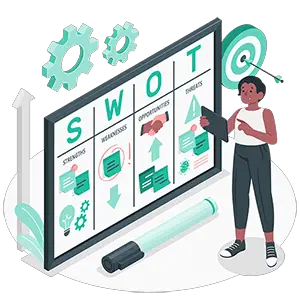
Root Cause Analysis
This is a method used to identify the underlying causes of a problem, rather than just addressing its symptoms. One popular technique within root cause analysis is the “ 5 Whys ” method. This involves asking “why” multiple times (traditionally five) until the fundamental cause of the problem is uncovered. This technique encourages deeper thinking and can reveal connections that aren’t immediately obvious. By addressing the root cause, solutions are more likely to be effective and long-lasting.

Mind Mapping
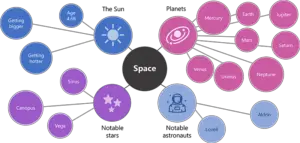
Each of these tools and techniques can be adapted to different types of problems and situations. Effective problem solvers often use a combination of these methods, depending on the nature of the problem and the context in which it exists. By leveraging these tools, one can enhance their ability to dissect complex problems, generate creative solutions, and implement effective strategies to address challenges.
Developing Problem-Solving Skills
Developing problem-solving skills is a dynamic process that hinges on both practice and introspection. Engaging with a diverse array of problems enhances one’s ability to adapt and apply different strategies. This exposure is crucial as it allows individuals to encounter various scenarios, ranging from straightforward to complex, each requiring a unique approach. Collaborating with others in teams is especially beneficial. It broadens one’s perspective, offering insights into different ways of thinking and approaching problems. Such collaboration fosters a deeper understanding of how diverse viewpoints can contribute to more robust solutions.
Reflection is equally important in the development of problem-solving skills. Reflecting on both successes and failures provides valuable lessons. Successes reinforce effective strategies and boost confidence, while failures are rich learning opportunities that highlight areas for improvement. This reflective practice enables one to understand what worked, what didn’t, and why.
Critical thinking is a foundational skill in problem-solving. It involves analyzing information, evaluating different perspectives, and making reasoned judgments. Creativity is another vital component. It pushes the boundaries of conventional thinking and leads to innovative solutions. Effective communication also plays a crucial role, as it ensures that ideas are clearly understood and collaboratively refined.
In conclusion, problem-solving is an indispensable skill set that blends analytical thinking, creativity, and practical implementation. It’s a journey from understanding the problem to applying a solution and learning from the outcome.
Whether dealing with simple or complex issues, or structured or unstructured challenges, the essence of problem-solving lies in a methodical approach and the effective use of various tools and techniques. It’s a skill that is honed over time, through experience, reflection, and the continuous development of critical thinking, creativity, and communication abilities. In mastering problem-solving, one not only addresses immediate issues but also builds a foundation for future challenges, leading to more innovative and effective outcomes.
- Mourtos, N.J., Okamoto, N.D. and Rhee, J., 2004, February. Defining, teaching, and assessing problem solving skills . In 7th UICEE Annual Conference on Engineering Education (pp. 1-5).
- Foshay, R. and Kirkley, J., 2003. Principles for teaching problem solving. Technical paper , 4 (1), pp.1-16.
Q: What are the key steps in the problem-solving process?
A : The problem-solving process involves several key steps: identifying the problem, defining it clearly, analyzing it to understand its root causes, generating a range of potential solutions, evaluating and selecting the most viable solution, implementing the chosen solution, and finally, reviewing and reflecting on the effectiveness of the solution and the process used to arrive at it.
Q: How can brainstorming be effectively used in problem-solving?
A: Brainstorming is effective in the solution generation phase of problem-solving. It involves gathering a group and encouraging the free flow of ideas without immediate criticism. The goal is to produce a large quantity of ideas, fostering creative thinking. This technique helps in uncovering unique and innovative solutions that might not surface in a more structured setting.
Q: What is SWOT Analysis and how does it aid in problem-solving?
A : SWOT Analysis is a strategic planning tool used to evaluate the Strengths, Weaknesses, Opportunities, and Threats involved in a situation. In problem-solving, it aids by providing a clear understanding of the internal and external factors that could impact the problem and potential solutions. This analysis helps in formulating strategies that leverage strengths and opportunities while mitigating weaknesses and threats.
Q: Why is it important to understand the nature of a problem before solving it?
A : Understanding the nature of a problem is crucial as it dictates the approach for solving it. Problems can be simple or complex, structured or unstructured, and each type requires a different strategy. A clear understanding of the problem’s nature helps in applying the appropriate methods and tools for effective resolution.
Q: How does reflection contribute to developing problem-solving skills?
A : Reflection is a critical component in developing problem-solving skills. It involves looking back at the problem-solving process and the implemented solution to assess what worked well and what didn’t. Reflecting on both successes and failures provides valuable insights and lessons, helping to refine and improve problem-solving strategies for future challenges. This reflective practice enhances one’s ability to approach problems more effectively over time.

Daniel Croft
Daniel Croft is a seasoned continuous improvement manager with a Black Belt in Lean Six Sigma. With over 10 years of real-world application experience across diverse sectors, Daniel has a passion for optimizing processes and fostering a culture of efficiency. He's not just a practitioner but also an avid learner, constantly seeking to expand his knowledge. Outside of his professional life, Daniel has a keen Investing, statistics and knowledge-sharing, which led him to create the website www.learnleansigma.com, a platform dedicated to Lean Six Sigma and process improvement insights.

Free Lean Six Sigma Templates
Improve your Lean Six Sigma projects with our free templates. They're designed to make implementation and management easier, helping you achieve better results.
Was this helpful?

Problem-solving in Leadership: How to Master the 5 Key Skills
The role of problem-solving in enhancing team morale, the right approach to problem-solving in leadership, developing problem-solving skills in leadership, leadership problem-solving examples.
Other Related Blogs
What’s the Role of Problem-solving in Leadership?
- Getting to the root of the issue: First, Sarah starts by looking at the numbers for the past few months. She identifies the products for which sales are falling. She then attempts to correlate it with the seasonal nature of consumption or if there is any other cause hiding behind the numbers.
- Identifying the sources of the problem: In the next step, Sarah attempts to understand why sales are falling. Is it the entry of a new competitor in the next neighborhood, or have consumption preferences changed over time? She asks some of her present and past customers for feedback to get more ideas.
- Putting facts on the table: Next up, Sarah talks to her sales team to understand their issues. They could be lacking training or facing heavy workloads, impacting their productivity. Together, they come up with a few ideas to improve sales.
- Selection and application: Finally, Sarah and her team pick up a few ideas to work on after analyzing their costs and benefits. They ensure adequate resources, and Sarah provides support by guiding them wherever needed during the planning and execution stage.
- Identifying the root cause of the problem.
- Brainstorming possible solutions.
- Evaluating those solutions to select the best one.
- Implementing it.

- Analytical thinking: Analytical thinking skills refer to a leader’s abilities that help them analyze, study, and understand complex problems. It allows them to dive deeper into the issues impacting their teams and ensures that they can identify the causes accurately.
- Critical Thinking: Critical thinking skills ensure leaders can think beyond the obvious. They enable leaders to question assumptions, break free from biases, and analyze situations and facts for accuracy.
- Creativity: Problems are often not solved straightaway. Leaders need to think out of the box and traverse unconventional routes. Creativity lies at the center of this idea of thinking outside the box and creating pathways where none are apparent.
- Decision-making: Cool, you have three ways to go. But where to head? That’s where decision-making comes into play – fine-tuning analysis and making the choices after weighing the pros and cons well.
- Effective Communication: Last but not at the end lies effective communication that brings together multiple stakeholders to solve a problem. It is an essential skill to collaborate with all the parties in any issue. Leaders need communication skills to share their ideas and gain support for them.
How do Leaders Solve Problems?
Business turnaround, crisis management, team building.
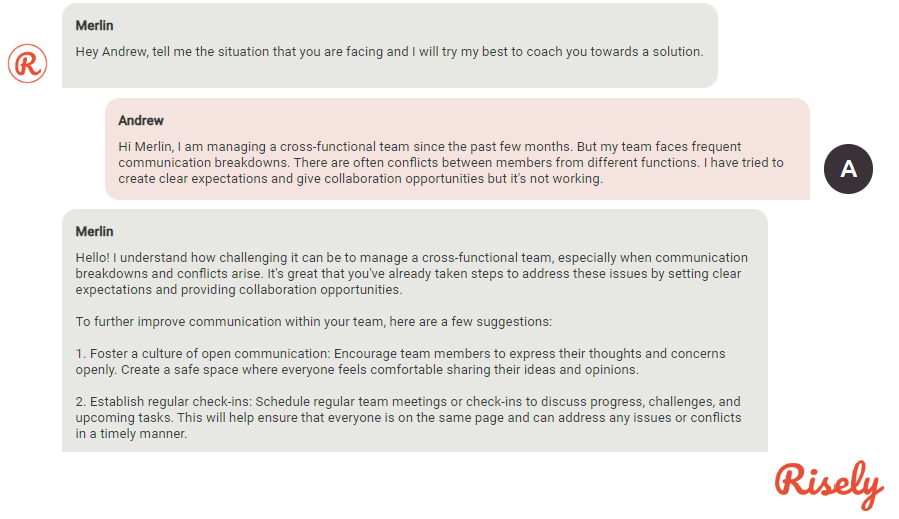
Process improvement
Ace performance reviews with strong feedback skills..
Master the art of constructive feedback by reviewing your skills with a free assessment now.
Why is problem solving important?
What is problem-solving skills in management, how do you develop problem-solving skills.

Top 15 Tips for Effective Conflict Mediation at Work
Top 10 games for negotiation skills to make you a better leader, manager effectiveness: a complete guide for managers in 2024, 5 proven ways managers can build collaboration in a team.
- Consultancy
- Online Courses
- All , Business Management , Lean , Lean Culture , Lean Management , Operational Excellence
5 Essential Problem-Solving Strategies Every Business Leader Should Know
- 4 mins to read
- April 2, 2024
- By Reagan Pannell
In the labyrinth of challenges that businesses encounter daily, effective problem-solving methods are the threads that lead to the cord that unifies success. But what happens when the labyrinth of issues grows complex? This is where the science and art of Lean Six Sigma come into play, offering a map not just to solve, but to anticipate, assess, and ameliorate problems systematically. Here are five essential strategies in the Lean Six Sigma arsenal that arm every business leader with the proficiency to overcome the most intricate of business conundrums.
Standard Work
Imagine your business as a well-kept vineyard; every grape must be picked at the right time and in the right way to salvage the flavour. This meticulous process, akin to Standard Work, involves establishing a precise procedure for every task—the one best way to ensure quality, safety, specificity, and efficient use of resources.
In a world where change is a constant, some might hesitate at the seemingly rigid nature of a ‘standard’ procedure. But Lean Six Sigma reminds us that without a standard, there is no baseline for improvement. Only after defining this ‘one-best-way’ can teams engage in the Plan-Do-Check-Act cycle, consistently fine-tuning the process to bear sweeter fruit. Standard Work is not an iron cage; it is the seeds of agility and improvement, sown in the fertile soil of stability.
The Ironclad Approach to Consistency
Standard Work chains down variance and unplanned activities, providing clarity in roles and expectations, and ultimately, nurturing a culture of standardised efficiency.
A Flexible Framework for Change
While providing a structure that supports current success, Standard Work continually evolves, integrating learning, and adapting to change.
Workplace Organisation
Imagine an orchestra without a conductor, notes fluttering about like startled birds. Without a specified order, the symphony of your workplace could devolve into cacophony. Enter Workplace Organisation, or the 5S method, an arrangement that ensures every tool has a place and every worker knows where it belongs and how to access it promptly.
More than just a cleanup, this strategic approach to organisation — Sort, Set in Order, Shine, Standardize, and Sustain — ensures that the environment supports the work, contributing to a systematic reduction in waste, both physical and temporally. A lean and organised workspace is the incubator of efficiency and safety, nurturing an environment where problem-solving seeds can sprout and grow.
Systematically Reduce Waste
The 5S method eliminates the unnecessary, decluttering not just space, but also time, motion, and waiting in the production process.
A Safe, Structured Haven
An organized workplace isn’t just efficient; it safeguards against errors and accidents, allowing the workforce to operate in a setting conducive to excellence.
- Lean Consultancy
- Corporate Training
The 3 Cs — A daily dose of continuous improvement
Every detective knows that a good case requires a thorough investigation. In the domain of Lean Six Sigma, those clues are the 3Cs — Concern, Cause, and Countermeasure, and the detective is the continuous improvement team. This technique, well-suited to stubborn and recurring problems, involves daily huddles where teams voice concerns and collectively dig through the possible causes before unveiling countermeasures to prevent a recurrence.
The power of the 3Cs lies not only in their commitment to root-cause analysis but also in the sense of shared responsibility and action. In gathering daily, teams promote a heightened awareness of the issues, foster creative, proactive problem-solving strategies, and ultimately drive an operation saw-toothed with continual improvements.
Daily Reassessment and Realignment
The 3Cs keep a vigilant watch over operations, ensuring that daily changes are reflected in the problem-solving strategy.
A Unified Front in the Battle Against Waste
By involving the entire team, the 3Cs push towards the most effective of countermeasures, using everyone’s expertise in the cause.
The A3 Approach—The Art of Story Telling
Storytelling is a powerful form of communication—it takes the listener on a structured journey of discovery, conflict, and ultimately, a resolution. The A3 Problem Solving Methodology encapsulates this approach by having problem solvers tell the story of a problem on a single sheet of A3 paper, guiding them through planning, analysis, implementation, and evaluation. This pictorial presentation not only aids in breaking down complex issues but also ensures that stakeholders can follow the story to its end, taking a valuable role in the resolution.
While it may seem like a reductive approach to confine a problem to a single page, the A3 Methodology instead empowers by distillation. It distills the ‘noise’ around an issue into a coherent narrative, allowing all involved to see the forest for the trees, and the path ahead unburdened by confusion.
Simplifying the Complex
The A3 method breaks down labyrinthine problems into bite-sized segments, making them manageable and digestible.
Involving Every Stakeholder
By presenting the complexity of issues in a clear, visual format, more voices can contribute to the resolution, ensuring a comprehensive and effective solution.
DMAIC — The Master Design of Problem Solving
DMAIC (Define, Measure, Analyse, Improve, Control) is Lean Six Sigma’s strategic playbook for solving complicated problems. Like the grandmaster in a chess game, the DMAIC process doesn’t just walk you through the paces; it shapes your moves in response to a methodical assessment of the board and the current state of the game.
Beginning with a problem definition and culminating in the systematic control and monitoring of the implemented solution, DMAIC is about setting the parameters, calculating your options, and making moves that carry you to victory in the quest for efficiency and excellence, the game of business.
Empowering Data-Driven Decisions
At the heart of DMAIC lies statistical analysis and hard data, ensuring that every step is bolstered by evidence and precision.
The Continuous Improvement Spectrum
DMAIC isn’t just about solving a problem; it’s about embedding a mindset that perpetuates Lean Six Sigma’s principles in every facet of the business.
In Conclusion
Problem-solving is not just about fixing what’s broken; it’s about fortifying your business against surprises and setbacks. Lean Six Sigma’s problem-solving strategies offer a systematic, structured, and data-driven approach that every business leader can harness. Whether it’s establishing a workflow, organizing the workspace, engaging in daily problem-solving practices, or navigating complex problem-solving methodologies, these tools are the blueprint to building a resilient, robust business that thrives in the face of adversity.
For those leaders, professionals, and CI practitioners versed in the language of Lean Six Sigma, mastering these strategies isn’t just a competitive edge; it’s a mandate. The markets swell with competition, and only those with the sharpest problem-solving techniques will carve out a niche and not just survive, but excel. It’s time to ask yourself — will you grapple with problems, or will you solve them with finesse and finesse impacting not only a moment but a legacy? Lean in, employ these strategies, and watch as you transform from problem-facer to problem-solver extraordinaire.
Stay current with our latest insights
- Lean Six Sigma Yellow Belt Course
Our Training Courses
Fundamentals of lean.
- Lean Six Sigma White Belt Course
- Lean Thinking Business Course
- Lean Six Sigma Green Belt Course
- Lean Six Sigma Black Belt Course
Yellow Belt Course
View all courses, recent articles, 2024 recommended reads for transformative thinking, 10 best books on agile, scrum and design thinking, the ultimate guide to lean and manufacturing: boosting efficiency and productivity, 10 best management books for leaders and change makers, mastering software development agile: a practical guide, the most popular tools of six sigma, view all articles, green belt course, other articles, time thieves: how time slips away, the key elements of project management and managing project portfolios , 05 – work to establish standardised processes, sources of error in measurement in research methodology: bias and precision – leanscape, what is a priortisation matrix, what is sigma in six sigma, and what does it mean for you, what is kanban explained in 10 minutes, 90-day facility management turnaround with 27% lift in performance, 04 – am i adding value, why are control plans essential in project management, the power of lean thinking to transform business performance, financial services company takes bold steps to improve productivity, related articles, pareto’s principle: the 80/20 rule, the box-cox transformation: what it is and how to use it, newsletter | investing in yourself to make lasting change, the top benefits of lean six sigma training & certification, the average is always wrong, lean six sigma online courses.
FREE COURSE | YELLOW BELT | GREEN BELT | BLACK BELT | MASTERCLASS | WORKSHOPS
Lean Accelerator Progam
A Lean Six Sigma Green Belt Masterclass
Ready to start your journey into the world of Lean with this free course?
FREE COURSE
Lean Thinking
A Lean focused continious improvement certification course
LSS Yellow Belt
Propel your career forward, tackle complex problems and drive change
LSS Green Belt
The ultimate fast-track for future leadership
LSS Black Belt
Become an expert in change management and complex problem-solving.
Subscribe to Newsletter
Keep up to date to the latest insights, courses, training, webinars and more. Join our newsletter today.
Lean Accelerator Program
Discover the power of problem-solving, 15 min per day | 3-months | only €999 | learn from experts.
- eNewsletter Subscription
- Great Question Podcast
- Search Search
Members Only
- Technology & IIoT
- Supply Chain
- The Economy

- Continuous Improvement
Designing a Lean Problem-Solving System with Purpose
The following is an excerpt from People Solve Problems: the Power of Every Person, Every Day, Every Problem (2021: Old Dutch Group), the latest book by IndustryWeek lean leadership contributor Jamie Flinchbaugh.
Too often, managers at all levels operate the same way during the lean journey as they did before, just with some lean lingo thrown in for good measure. They might ask someone to do an A3 and feel they are doing their part for the journey. But a manager has responsibilities in the journey that go beyond using the words and supporting the journey with resources. For starters, they must be an architect of the system of work that drives effective problem-solving.
What does it mean to be the system architect? It means that you take responsibility and ownership of the systems of work that expose problems, capture them, manage them, put resources to them and ultimately, solve them. Sending people to problem-solving training might fall into that category, but that is the easy step and far from sufficient to build an effective problem-solving organization.
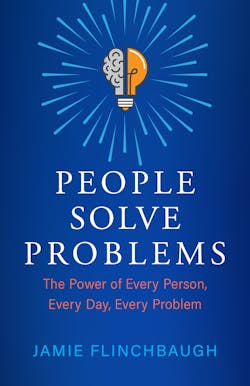
Some of the key elements could, or should, be organizational standards. But someone needs to set these standards, and senior management should be highly engaged in this process. How much to standardize across an organization is worthy of some debate and depends on the organization, the existing culture, the change strategy and the level of maturity.
However, even if you adopt a strong bias toward organizational standardization, there is still much work to be done by each director or manager for their own team’s work. Standards for this work are rarely much more than guidelines, perhaps with a few IT tools thrown in. The reason for this is that all problem-solving is contextual, and you must shape your systems for the nature and content of your work.
The Landscape of Problems
We begin with what I like to call the landscape of problems. There are many sources of problems and many sources of finding those problems. Yet most teams end up deciding what problem to engage with next rather randomly, without respect to the entire landscape. Consider these many sources:
You probably have key metrics, or Key Performance Indicators, that you monitor. When properly designed, they should have a clear definition of when things are normal and when they are abnormal. When a key metric hits an abnormal level, problem solving could be initiated.
You may have standard work that helps you consistently perform your team’s tasks. However, sometimes there is a problem and the standard cannot be followed or ceases to work as designed. This condition could drive problem-solving.
You do audits of the work, ranging from a simple 5S audit to a complex customer process audit. These audits generally produce findings, each of which can be defined as a problem.
You develop a culture of identifying waste using the lens of the seven wastes and perform waste walks of the process. Each waste occurrence found is a problem that could be solved.
You fail to meet a deliverable to a customer, internal or external. You are asked what will be done about it, which means you have a problem that needs to be solved and reported back to that customer.
Your team is frustrated with something, and it is a persistent topic of conversation and drag on the team. They would like the problem fixed.
And there are more sources of problems. Here is the challenge: if each source of potential problems is managed and reacted to independently, you have no strategy for what problems you really should be solving. The simplest way to manage your landscape of problems strategically is to have a single list of problems regardless of where the problem is found, but a single list does not have to be your solution. As a leader, you must have an awareness of all the sources of problem identification and a system of work for examining and engaging with them in a balanced and purposeful way. You must have a systematic approach to managing your problem landscape. Otherwise, your team will react to each next problem that pops up in their inbox, which gives you extraordinarily little control of managing your improvement path.
The Andon, or Help Chain
A core element of your system is how you connect help to any problem as it occurs. Andon is a Japanese word meaning “lantern,” which relates to our situation as a signal light to indicate that there is a problem. If you prefer words that are more descriptive for your use, I like to call this the help chain because it is what connects help to the problem occurrence. While not every problem in your problem landscape will receive systematic problem-solving, every problem should receive attention.
To do this, you must define all of these five elements that are context-specific to the environment in which you work. First, you must define those problems that should be escalated and those that should not. For example, if your process takes five to six days, is that a problem or just natural variation of your work? More importantly, if I think you have a problem at four days and you don’t think it is a problem until you reach seven days, then in between those two markers, we are going to have plenty of frustrating tension. We should have the same definition of what is a problem.
Next, you need a way to notice the problem . This is one of the reasons that, in a lean environment, we strive to make the work as visual as possible so it is easier to detect the problem. Again, this is extremely specific to the nature of the work and must be solved at a local level.
Third, you need a method to escalate the problem . What is the one, and ideally only, way to surface that problem? The reason for the term “andon” is that the original creation of this approach was in a manufacturing environment at Toyota where a light would turn on and music would play. But a pilot declaring “Mayday” is a code word that accomplishes the same task, as is an error message popping up on your computer. There are many ways to create a signal, but it should be simple, timely, and very clear. These three elements make up the request for help.
The next two elements make up the response to that request. We must determine who is the right person to respond. This is often assumed to be the immediate manager, but this is the case only if they are able to provide the necessary help. Make sure the right resource is connected, either to coach or to solve. And finally, how do they respond , and just as importantly, when do they respond? This should be standardized so the other end of that help chain is not wondering whether, when, and in what form that help is going to arrive.
Managing and Prioritizing the Problems
Whether you are managing 10 problems or a hundred, you need some method to ensure they are captured and being worked on. If they exist somewhere in an email thread from five days ago or scrib- bled in the margin of someone’s notebook, that is not a very reliable or transparent system. You may determine you want a single team list that is easy for everyone to monitor, but again, the details should fit your needs and your team’s work environment.
There are a couple of elements that are important to include. Ownership of the problem should be clear. A team cannot own a problem, because when it stalls, who do I look to for an explanation? Even if the person who owns it is doing only a small portion of the work, there has to be a person clearly accountable for pushing the problem forward.
Progress made is also important to understand. It is easy for problems to stall, but they must be pushed through whatever barriers were holding them back. All of this should be transparent. Knowing what is being worked on, and what is not, is not only useful inside the team, but it is also useful to those higher up the organizational chart and out to your internal customers and suppliers.
Within that system, prioritization is also important. If your team is very proficient at both solving problems and keeping them small, then first in, first out is a great and simple system. You manage the inbound on the problem landscape, and then once you start them, you push through to the end without interruption.
However, if your problems are too large or your capacity to solve them is too small, problems tend to linger. Then you need to dynamically prioritize the set of problems being worked on. I suggest focusing on prioritizing what to finish rather than what to start. It is easy to start new problems, but what needs to get finished? Getting finished means you are able to realize the performance benefits but also the learning and the sense of accomplishment. The latter two are the fuel that allows you to get the next problem done as well. Focus on getting problems finished.
Build Capacity and Capability
No matter how well-developed your system for managing problems, it will perform only as well as your team’s capacity and capability to solve problems. As a leader, it is your responsibility to build both. Capability is relatively straightforward. Who is trained? Who is practicing? Who is at what level of competence? The most important aspect that you must determine is where everyone will go for coaching help. Coaching is the main lifeblood of problem-solving capability. Everyone in your organization should be, ideally, one step removed from a coach. Maybe you, as the leader, are going to act as the coach. Are you prepared for that? Will you make yourself available on their terms and not your terms? It is usually not the willingness to coach, but the willingness to design your own work around being available to be a coach that is the bigger challenge.
Maybe the coach is someone within your team. They will have the same challenge. When you say, “Lisa will be our coach,” then through whatever means you manage your team’s workload, that must be taken into account. Coaching cannot stop just because Lisa has a busy month ahead.
Capacity is a bit trickier. Over time, as we solve more problems, our work becomes more stable, and we end up with greater capacity. But today, we still must “carve out” or “make” time for problem solving. This is much easier to do at the team or organizational level than at the individual level.
Building capacity begins with properly valuing time spent in problem-solving relative to other work. The work never all gets done before everyone goes home at the end of the day. Therefore, some stuff gets done and other work does not. How do you decide? Based on what you value! If you value polishing PowerPoint and attending every meeting you are invited to more than you value problem-solving, then that is the work that will get done and problem-solving will have to wait. As the leader, you have to first decide, and then communicate, how much problem-solving is valued.
Then you must develop a system that ensures the work gets done. If you look at your employees’ calendars and they have five review meeting notices from you but nothing carved out for problem solving, it sends a pretty clear signal of what is important. The easiest way to signal the importance is to commit the team’s time. This could be done by blocking off an hour a day, or an afternoon, or some form of clear capacity commitment. It is your system of work and your system of priorities. How will your decisions signal what you value? How will you design your team’s system to drive the priority?
We all work as part of a system. As a leader, you are responsible for this system of work getting the right things done. Your role is to be an architect and design your system with purpose.
The founder of JFlinch, Jamie Flinchbaugh has helped purpose-driven leaders craft effective, resilient organizations at over 300 companies. Jamie has helped leaders across a wide spectrum of industries including healthcare, utilities, technology, consumer products, and professional services, including Harley-Davidson, Intel, Mars, Amazon, Crayola, Fidelity, Whirlpool, among many others.
Continue Reading
Manufacturing 2015: 7 Thought Leaders Share Their Predictions
Lessons From Rockwell Automation's ESG Summit
Sponsored recommendations, voice your opinion, to join the conversation, and become an exclusive member of industryweek, create an account today.

So That Happened: You Know What Goes Really Well with M&Ms? Cheez-Its
Industrial Firms See Spending Holding Its Ground in Coming Quarters
The 3 E's of TPS and How the Basics Never Go Out of Style

Manufacturers Find a Workforce Friend in Black Churches

Reshoring Takes Hold Across Multiple Industries

So That Happened: Making Flags in America and Keeping Japanese Steel Companies Out
Fifty Factory Tours that Make America Great

Leading by solving (the right) problems
FEATURE – Leading by solving problems is a key trait of any lean leader, but it is important to understand that not all problems are their prerogative.
Words: Juan Ruiz , President, Lean Institute Colombia
In a world that looks increasingly complex – with pandemics, wars, high cost of raw materials, currency fluctuations, the great resignation, and so on – it is tempting to throw our hands in the air and simply blame the context for all the problems our businesses encounter. The truth is that, while difficult, the context is not the problem – our attitude as leaders is.
It is true that we don’t have control over the circumstances around us, but we do have control over how we lead. There is a lot of talk in the lean world about turning everyone into a problem solver, but what about the types of problems each of us solves every day? As a leader, are you thinking about the strategy of the business and developing people or are you fighting fires all over the place?
Here in Colombia, we are working a lot with Art Smalley’s categorization of problems, popularized in his 2018 book, and find that organizations draw huge benefits from it. According to Smalley, there are four types of problems, organized in two categories: Troubleshooting (Type 1), Gap-from-standard (Type 2), Target State (Type 3), Open-ended and Innovation (Type 4). Type 1 and 2 are caused/reactive, while Type 3 and 4 are created/proactive. Smalley’s framework explains how we can’t expect to use the same approach to address all kinds of problems and highlights the importance of ensuring that the right people solve the right problems. For example, some problems can be easily fixed by rapidly returning things to standards (Type 1), a prerogative of front-line workers, whereas applying kaizen to take a standard to new heights requires deeper thinking and analysis and is a clear responsibility of leadership.
Let’s investigate this a little more. Type 1 and 2 are a prerogative of front-line staff, the value creators: as experts in the process, they are best placed to tackle these problems. Higher up in the organization, the nature of problems changes drastically: this is where we talk about the organization as a system, there are shareholders to report to, and strategic decisions to make. Here, leaders have the opportunity to create problems to foster improvement and even lead to innovation. Only this can place the organization on a path towards steady growth and ensure its future. Based on all this, at management level, the proportion of Type 1 and 2 problem is low, and that of Type 3 and 4 is high. Or at least it should be.

What we observe is that leaders routinely solve problems one or two levels lower than they should. They love to “get their hands dirty” on the gemba and be in the operations. It’s what they know, what they are most comfortable with. Lean Thinking teaches us that going to see and being present at the gemba are a fundamental part of being a leader, but that doesn’t mean the problems that appear there should also be for leaders to solve. At the front line, leaders should act as coaches, enabling people to solve the problems themselves. Unfortunately, this doesn’t happen very often, and leaders struggle to get out of their comfort zone. This is the real problem – not to mention the reason your diaries constantly have a million meetings and appointments in them.
LEAN LEADERS STRIVE TO IMPROVE THEIR LEADERSHIP STYLE
Leaders who go beyond short-term goals understand that they are a problem and that they need to develop and change themselves before they develop others and ask them to change. As Michael Ballé explains, leading with respect means to involve people in improvement activities and teaching them the art of problem solving; not solving problems on their behalf or spoon-feeding them answers. Trusting that people can do a good job attacking and solving Type 1 and 2 problems creates a strong bond with them and encourages the entire organization to embrace the kaizen spirit. Coaching and supporting people in their problem-solving activities is the ultimate form of respect.
Smalley said that “managing is incidental work that enables value creation”. But when does that incidental work start to create waste? When leaders – somewhat cowardly – go to gemba not to observe, ask questions, and provide guidance, but to fix Type 1 problems. Call it what you like – micro-management, traditional management, etc – this is not what a leader should do. The same is true for more “modern” managers, who go the opposite way and expect to manage only with phones and digital tools. For them, AI and tech can fix it all.

Leading by solving problem means solving the right problems – those, in other words, that we are actually responsible for. This isn’t easy, and too many leaders still ask us to give them “the magic formula”. There isn’t one, just like there isn’t a company that you can go visit, whose processes you can simply copy and paste. (That includes Toyota… sorry.) What can you do, then? Start by addressing the shortcomings of your management system, by understanding where your current leadership behaviors are lacking and assigning the right management cadences and improvement methods to the different types of problems in front of you. In other words, face up to the right problems.
Some things to consider as you try and make this change:
- Think about the way you and your teams are solving problems.
- Remember that solving problems develops trust and helps to build relationships.
- Visualizing the flow of materials and information is important but visualizing the flow of problems is equally important. In other words, standardize your problem-solving activities (when I worked at Michelin, managers had to work on a new A3 every week).
- Without standardization, there are no problems (you just don’t see them). Indeed, standards are a precondition for improvement.
- Give your team the autonomy and knowledge to solve problems. You are the leader and, as such, you are supposed to develop people so they will solve problems, not you.
- As a leader who solves problems, get out of your comfort zone and start creating problems, rather than simply reacting to problems that are already there (caused ones).
Some good news for you: Lean Thinking was made for times of difficulty, when resources are scarce, and challenges abound. So, when there are too many problems and you feel overwhelmed, fulfil your role as a lean leader and start by asking yourself: how many of these problems are created? How many are caused? And, as a leader, which ones should I focus on?

NOTES FROM THE GEMBA – This month, Catherine visits a metal injection moulding specialist and hears about the strong link between growing people’s capabilities with lean thinking and staying competitive in a complex market.

INTERVIEW - We caught up with LEI’s Senior Advisor, Jim Morgan after his plenary talk at the Lean Summit in São Paulo last month and got him to answer a few questions about product development and lean management.

NOTES FROM THE (VIRTUAL) GEMBA – In the last of her series of virtual gemba walks, the author learns how a hospital in the Caribbean island of Martinique relied on Lean Thinking in its fight against the Coronavirus.

FEATURE – While at Starbucks, the author learned the importance of collaboration among the key functions of Operations, HR and Finance to advance a lean transformation.
Subscribe for our newsletter and get early access to all exclusive Planet Lean articles.

Wednesday, November 15, 2017
- The Seven Steps of Problem Solving

- Select the issue.
- Search for data to describe the situation.
- Analyze the facts to obtain root cause(s) of the performance gap.
- Select a solution.
- Conduct a pilot test.
- Evaluate performance.
- Standardize the gains, reflect, and repeat the process.
No comments:
Post a comment.
Search A Lean Journey
Twitter updates.
- Facebook Updates
- Advertising
Subscribe Now

Get new posts by email:
A Lean Journey LinkedIn Group
Recent comments, search this blog.
Top 10 Posts
- Celebrating my 500th Blog Post
- Visual Management Board
- Guest Post: Reduce, Reuse, Recycle...
- What Do We Mean By True North?
- The Six-Step Problem-Solving Process
- Five Lean Games Every Company Can Benefit From
- 10 Characteristics of a Good Measure and 7 Pitfalls to Avoid
- DOWNTIME and the Eight Wastes
- The 8 Common Wastes in an Office That Cause Downtime
- Lean Leadership: Lessons from Abe Lincoln
Blog Archive
- ► August (6)
- ► July (14)
- ► June (12)
- ► May (14)
- ► April (13)
- ► March (13)
- ► February (12)
- ► January (14)
- ► December (11)
- ► November (13)
- ► October (12)
- ► September (13)
- ► August (13)
- ► July (8)
- ► June (13)
- ► April (12)
- ► February (13)
- ► January (13)
- ► December (12)
- ► October (13)
- ► August (14)
- ► July (13)
- ► May (13)
- ► August (10)
- ► March (14)
- ► December (10)
- ► April (9)
- ► December (13)
- ► October (14)
- ► September (12)
- ► May (12)
- Lean Roundup #102 - November, 2017
- Lean Tips Edition #117 (1756-1770)
- Lean Quote: Gratitude is Something We Have to Prac...
- Happy Thanksgiving!
- Be Thankful This Thanksgiving
- Lean Quote: Developing Excellent Communication Ski...
- Guest Post: Empowering Others
- Lean Quote: Priorities and the Rule of Three
- Lean Administration: Time based Improvement Not Co...
- Guest Post: The Best Online Kanban Board Tools for...
- Lean Quote: Lean Goes Beyond Tools
- Lean Tips Edition #116 (1741 -1755)
- ► January (12)
- ► October (15)
- ► December (14)
- ► November (12)
- ► January (15)
- ► August (17)
- ► July (19)
- ► June (16)
- ► May (19)
- ► April (18)
- ► March (17)
- ► February (16)
- ► January (18)
- ► December (19)
- ► November (18)
- ► October (20)
- ► September (18)
- ► August (22)
- ► July (23)
- ► June (21)
- ► April (17)
- ► February (18)
- ► January (20)
- ► December (18)
- ► November (19)
- ► October (17)
- ► September (22)
- ► July (20)
- ► June (20)
- ► May (21)
- ► April (19)
- ► March (20)
- ► February (17)
- ► January (17)
- ► December (20)
- ► November (15)
- ► August (18)
- ► July (17)
- ► April (14)
- ► November (17)
- ► July (15)
- ► June (9)
- ► May (5)
- A Lean Journey (81)
- A Year Ago (8)
- ASQ's Influential Voices (40)
- Book Review (64)
- Change Management (53)
- Communication (13)
- Conference (10)
- Culture (38)
- Customer Focus (2)
- Daily Management (1)
- Development/Training (13)
- Empowerment (20)
- Engagement (37)
- Exercises/Games (8)
- Facilitation (2)
- Feedback (3)
- Guest Post (168)
- In the News (70)
- Innovation (2)
- kaizen (11)
- L.A.M.E. (5)
- Leadership (224)
- Lean and Green (12)
- Lean Basics (110)
- Lean Definition (25)
- Lean Fun (10)
- Lean in Practice (55)
- Lean Management (152)
- Lean Office (14)
- Lean Products (4)
- Lean Quote (735)
- Lean Resources (44)
- Lean Roundup (201)
- Lean Thinking (5)
- Lean Tips (237)
- Meet-up (34)
- Podcast (5)
- Problem Solving (21)
- Product Review (2)
- Project Management (6)
- Quality (50)
- Respect For People (57)
- Sharing Best Practices (129)
- Soft Skills (3)
- Strategy (6)
- Supply Chain (2)
- Talking Lean (1)
- Teamwork (42)
- Visual Factory (31)
- Webinar (23)
Lean Blogs I Like
- 2 Lean Principles
- 5S Supply Blog
- Avoiding The Corporate Death Spiral
- Be More Careful!
- Curious Cat
- Daily Kaizen
- Evolving Excellence
- Gemba Panta Rei
- Gemba Tales
- Got Boondoggle?
- Gotta Go Lean Blog
- Improve With Me
- Jamie Flinchbaugh
- Kaizen Notebook
- Lean Builder
- Lean Communications
- Lean For Everyone
- Lean Healthcare Exchange
- Lean Homebuilding
- Lean Insider
- Lean Is Good
- Lean Leadership
- Lean Pathways
- Lean Printing
- Lean Reflections
- Lean Simulations
- Lean Six Sigma Academy
- LeanCor Blog
- Learn Lean Manufacturing
- Learning About Lean
- Old Lean Dude Blog
- The A3 Post
- The Lean Edge
- The Lean Library
- The Lean Logistics Blog
- The Lean Thinker
- The Lean Way Consulting
- TimeBack Blog
- To The Gemba
- Training Within Industry
- Visual Management Blog
Other Sites I like
- AME's Target Magazine
- AnythingLean.com
- Art of Lean
- Bosch Rexroth Lean Production
- CIRAS - Theory of Constraints
- Chasing The Rabbit
- Corporate Event Management
- Creative Safety Supply
- Creative Safety Supply 5S Resource Page
- Fuss & O'Neill SPL
- Gemba Academy
- Grassroots Innovation
- IndustryWeek
- Lean Enterprise Institute
- Leanovations
- Learn More McGraw-Hill
- MEP University
- Manufacturers BlogNotions
- Manufacturing Business Technology
- Manufacturing Pulse
- Modern Machine Shop
- Running A Hospital
- Superfactory
- The 5S Store
- Unclutterer
- Visual Workplace
- Xtreme Lean Consulting
- catalyst for change
- freeleansite.com
wibiya widget
A lean journey blog - copyright © 2009-2024 tim mcmahon - all rights reserved.
LEI's Learning Portal
Intro to problem solving.
Problem solving is critical to every position in every industry. In this course, you will learn to grasp the situation at the gemba (where the work is done) and use all your senses to understand what is truly happening.
All too often, people create countermeasures to perceived problems without digging deeper, asking the right questions, and thinking more.
Throughout the entirety of the course, we use a case example to illustrate the problem-solving approach as you are learning. In addition, you will deepen your understanding by applying this new way of thinking to a problem of your choice.
This course breaks down lean problem-solving concepts and techniques into simple, easily understood pieces.
How do you solve problems?
Learning objectives.
This course works for people new to the concepts of lean and continuous improvement, for individuals looking to improve their lean understanding and skills, and for organizations wanting to level set the lean knowledge of their workforce to speed progress.
Build a foundational understanding of problem types and problem solvingIdentify the four types of problems
Resolve business challenges by using scientific method, PDCA-based problem solving
Apply A3 thinking to solve problems
Clearly define problems, beginning with grasping the situation at gemba
Learn to break down vague problems to specific problems that can be solved to root cause
Time Estimates Per Unit*
*Actual times may vary.
| Unit 1: Problem Solving | 45 minutes |
| Unit 2: What is an A3? | 2 hours |
| Unit 3: Creating Your A3 | 6.5 hours |
| Work-based Activities | 10+ hours |
Course Units
Expand to view lessons
Course Introduction
0.1 Welcome!
0.2 Platform Tour (optional)
0.3 Copyright Acknowledgment
0.4 Curriculum Concept Map (Visual Syllabus)
0.5 Supplemental Textbook
Unit 1: Lean Problem Solving
1.1.1 | Welcome to Introduction to Problem Solving!
1.1.2 | Lean Transformation Framework
1.1.3 | How We View Problems
1.1.4 | Lead with a Questioning Mindset
1.2.1 | What's a Problem
1.2.2 | Problems Problems Problems
1.2.3 | Four Types of Problems
1.2.4 | Four Types of Problem Solving
1.2.5 | Make the Problem Clear
1.2.6 | Problem Breakdown Analysis
1.2.7 | Unit 1 Personal Reflection
Unit 2: What is an A3?
2.1.0 Helpful information for working on Your A3
2.1.1 | Introduction to A3
2.1.2 | A3 Basics
2.1.3 | Simple A3 Example
2.1.4 | A3 as Good Storytelling
2.1.5 | It's Not a Template
2.1.6 | 5-Step A3 Example
2.1.7 | Your A3: Title and Owner
2.1.8 | Introduction and Chapter 1 (optional)
2.2.1 | Develop Problem Solvers
2.2.2 | Developing Problem Solvers at Herman Miller
2.2.3 | The A3 Process
2.3.1 | Basic Thinking, Mindset, Assumptions
2.3.2 | Porter’s First A3: Rush to a Solution
2.3.3 | Rethinking Thinking by Trevor Maber
2.3.4 | What do I need to know
2.3.5 | Chapter 2: Grasp the Situation—Part 1 (optional)
2.3.6 | Unit 2 Personal Reflection
Unit 3: Your A3
3.1.1 | Grasp the Situation at the Gemba
3.1.2 | Gemba Is More than a Place from Managing to Learn (optional)
3.1.3 | Go See, Ask Why, Show Respect
3.1.4 | Chapter 2: Grasp the Situation—Part 2 (optional)
3.1.5 | Porter’s First Revised A3
3.1.6 | Problem-solving Funnel (Part 1)
3.1.7 | Your A3: Background & Current Condition
3.2.1 | Analysis (part 1)
3.2.2 | Problem-solving Funnel (Part 2)
3.2.3 | Chapter 3: Goals and Analysis—Part 1 (optional)
3.2.4 | Your A3: Background & Current Condition - update
3.2.5 | Analysis (part 2)
3.2.6 | The Five Whys
3.2.8 | The Five Whys Animation
3.2.9 | Problem-solving Funnel (Part 3)
3.2.10 | Your A3: Goal, Target and Analysis
3.3.1 | Choose Countermeasures
3.3.2 | Countermeasures vs. Solutions (optional)
3.3.3 | PICKing Countermeasures
3.3.4 | Your A3: Countermeasures
3.4.1 | Create a Plan
3.4.2 | Nemawashi from Managing to Learn (optional)
3.4.3 | Consensus/Agreement from Managing to Learn (optional)
3.4.4 | From Position Based Authority to Pull-Based Authority (optional)
3.4.5 | Chapter 5: Plan and Followup—Part 1 (optional)
3.4.6 | PDCA from Managing to Learn (optional)
3.4.7 | PDCA Improvement
3.4.8 | Your A3: Plan
3.5.1 | Followup
3.5.2 | Chapter 5: Plan and Followup—Part 2 (optional)
3.5.3 | Detailed A3 Template
3.5.4 | Your A3: Followup
3.5.5 | Conclusion and Getting Started (optional)
3.5.6 | Unit 3 Personal Reflection
3.5.7 | Course Summary
Final Course Survey and Certificate of Completion
Final Course Survey
Certificate of Completion
Continue Your Lean Learning
Extra Resources
More books from the Lean Enterprise Institute
A3 Thinking Questions
More learning experiences from the Lean Enterprise Institute
More on the 'Ladder of Inference'
More on 'Leading with a Questioning Mindset'

About this course
- 0.5 hours of video content

Senior Instructor John Shook
Shook co-authored Learning to See, the book that introduced the world to value-stream mapping. He also co-authored Kaizen Express, a bi-lingual manual of the essential concepts and tools of the Toyota Production System. With Managing to Learn, Shook revealed the deeper workings of the A3 management process that is at the heart of Toyota’s management and leadership.
Worth every minute spent!
Christy leite.
This training covers what other root cause training don’t: The Social-Technical system which is equally important to using problem solving tools when handlin...
This training covers what other root cause training don’t: The Social-Technical system which is equally important to using problem solving tools when handling a problem. Problem definition is where most teams fall short. This training covers that well with excellent application examples. Definitely worth taking!
Wish i learned this at the beginning of my career
Jonathan fairweather.
would have saved alot of headake on alot of problem solving arguements ect and got to the root problem
Outstanding
William butdorf.
Very organized and professionally delivered.
It's Not Just a Piece of Paper
You really have to try and put the simplest problem you think you have and see if you can fix or solve it with a sentence or paragraph about what you should ...
You really have to try and put the simplest problem you think you have and see if you can fix or solve it with a sentence or paragraph about what you should do. Then apply the A3 methodology... I bet you find it isn't one simple problem and you might just discover how complex the problem is, what else is affected that you never realized, or who else might be aware or impacted by it. It's just thinking outside the box and being open to solving the problem. I think to many people don't want to expose a problem because they don't know how to fix it or that it's a failure to have problem at all
Additional Courses

Learning to See Using Value Stream Mapping - with Live Coaching
This workshop shows you how to make and apply this fundamental and critical tool based on the Lean Enterprise Institute's groundbreaking value-stream mapping workbook, Learning to See, which has introduced the mapping tool to thousands of people.

Intro to Lean Thinking & Practice
This online course serves as an introduction to the key concepts, philosophies, and tools associated with lean thinking and practice.

Lean Fundamentals Bundle
Buy all three fundamentals courses at reduced cost. Purchase for yourself or your entire enterprise.
Stay connected on all things lean thinking and practice.
Add your email to LEI's mailing list to get the latest updates.
Please enter a valid email address
Please check this box if you wish to proceed
Oops, something went wrong. Please try again with a different email address.
Log in using your username and password
- Search More Search for this keyword Advanced search
- Latest content
- For authors
- Browse by collection
- BMJ Journals
You are here
- Volume 9, Issue 6
- Role of lean leadership in the lean maturity—second-order problem-solving relationship: a mixed methods study
- Article Text
- Article info
- Citation Tools
- Rapid Responses
- Article metrics
- Arie Bijl 1 ,
- Kees Ahaus 1 , 2 ,
- Gwenny Ruël 1 ,
- Paul Gemmel 3 ,
- Bert Meijboom 4
- 1 Department of Operations , Faculty of Economics and Business, Erasmus University Rotterdam , Rotterdam , The Netherlands
- 2 Department of Health Services Management & Organisation, Erasmus School of Health Policy & Management , Erasmus University Rotterdam , Rotterdam , The Netherlands
- 3 Department of Innovation, Entrepreneurship and Service Management, Faculty of Economics and Business Administration , Ghent University , Gent , Belgium
- 4 Department of Tranzo , Tilburg University , Tilburg , The Netherlands
- Correspondence to Prof. Kees Ahaus; ahaus{at}eshpm.eur.nl
Objectives To investigate the relationship between lean adoption and problem-solving behaviour in nursing teams, and to explore the practices of lean leaders on nursing wards to reveal how they can stimulate second-order problem-solving within their teams.
Design A mixed-methods retrospective multiple case study using semistructured interviews. Interview data were used to assess the level of lean maturity (based on a customised validated instrument) and the level of second-order problem-solving (based on scenarios). Within-case and cross-case analyses were employed to identify lean leadership practices.
Setting 14 nursing teams, with different levels of lean maturity, in a Dutch hospital.
Participants Three members of each nursing team were interviewed: the team leader, one nurse from the ward’s core team for the lean-based quality improvement programme and one nurse outside the core team.
Interventions The nursing teams were in various phases of a lean-based quality improvement programme: ‘The Productive Ward – Releasing Time to Care’.
Results A strongly significant positive relationship between lean maturity and second-order problem-solving was found: β=0.68, R 2 =0.46, p<0.001. Further, the results indicated a potential strengthening effect of lean leadership on this relationship. Seven lean leadership practices emerged from the data collected in a nursing ward setting: (1) convincing and setting an example; (2) unlocking individual and team potential; (3) solving problems systematically; (4) enthusing, actively participating and visualising; (5) developing self-managing teams; (6) sensing, as orchestrator, what is needed for change; and (7) listening, sharing information and appreciating. These practices have a strong link with transformational leadership.
Conclusions As lean matures, nursing teams reach a higher level of second-order problem-solving. In later stages, lean leaders increasingly relinquish responsibility by developing self-managing teams.
- lean leadership
- lean maturity
- second-order problem solving
This is an open access article distributed in accordance with the Creative Commons Attribution 4.0 Unported (CC BY 4.0) license, which permits others to copy, redistribute, remix, transform and build upon this work for any purpose, provided the original work is properly cited, a link to the licence is given, and indication of whether changes were made. See: https://creativecommons.org/licenses/by/4.0/ .
https://doi.org/10.1136/bmjopen-2018-026737
Statistics from Altmetric.com
Request permissions.
If you wish to reuse any or all of this article please use the link below which will take you to the Copyright Clearance Center’s RightsLink service. You will be able to get a quick price and instant permission to reuse the content in many different ways.
Strengths and limitations of this study
The study fills a gap in knowledge as to whether more mature lean teams show a higher level of second-order problem-solving behaviour.
In addition, it provides valuable insight into typical lean leadership practices and how these are linked to mainstream leadership theories.
Future research attempting to measure lean maturity in healthcare environments may benefit from using the newly developed and validated scale that incorporates six items from Malmbrandt and Ahlström’s instrument.
Another strength of the study is its use of Gioia methodology to inductively analyse the lean leadership data.
A limitation is that the nursing teams all came from one Dutch hospital, however, this choice had the benefit that it provided nursing teams with a range of lean maturities working under similar circumstances.
Introduction
The earliest applications of lean thinking in the healthcare sector were more than a decade ago. Since then, lean has gained in popularity in the sector. 1 The primary goals of lean in healthcare have been to increase the quality of care and to increase efficiency. 2 To achieve these goals, most healthcare organisations have emphasised the application of lean tools to reduce direct waste, but neglected developing the problem-solving abilities of frontline employees. 3 This approach may have created some process improvements, but long-term hospital-wide benefits have rarely been achieved. 4
To realise more of lean’s potential, it is often suggested that structured problem-solving should be developed throughout the organisation to sustainably improve processes. 3 This is inspired by Liker’s 4P model that identifies four aspects of lean: philosophy, process, people and problem-solving. 3 One well-known and effective approach to this is second-order problem-solving. This involves the in-depth questioning of work practices to uncover and remove the root causes of problems. 5 This approach is in sharp contrast with first-order problem-solving where problems are resolved in an ad-hoc manner, while underlying causes remain. 6 A recent study by Gemmel et al 3 suggests that second-order problem-solving is more prevalent than first-order problem-solving in nursing teams with high levels of lean maturity. However, evidence from a larger sample of wards is needed to confirm this.
Earlier studies have suggested that team leaders could stimulate second-order problem-solving behaviour by nurses. 5 Team leaders are crucial in creating and sustaining the benefits of lean adoption on hospital wards since they can help to create a culture of continuous improvement, empower frontline employees and foster participation. 7–9 Although the literature often emphasises the importance of lean leadership, there are few empirical studies of lean leadership in healthcare. 9 10 Moreover, previous studies have not connected lean leadership with other leadership theories. 9 Consequently, an in-depth empirical study of lean leadership on nursing wards is needed, whereby the identified leadership practices can be positioned within existing leadership approaches in order to enhance our understanding of this concept.
In this paper, we study the relationship between lean maturity and second-order problem-solving behaviour. In addition, we explore the meaning attached to lean leadership on nursing wards and discover how lean leadership moderates the lean maturity—second-order problem-solving relationship. In our study of the lean leadership concept, we focus solely on identifying leadership practices on nursing wards (ie, in terms of team leadership). We answer the following research questions:
How does lean maturity affect the problem-solving behaviour of nursing teams?
What constitutes lean leadership on nursing wards?
How does lean leadership affect the relationship between lean maturity and second-order problem-solving?
Lean maturity
The concept of lean maturity needs careful consideration if one is to accurately assess the impact of lean implementation on the problem-solving behaviour of nursing teams. 3 Malmbrandt and Åhlström 11 argue that the extent of an organisation’s lean adoption can be measured using an instrument that incorporates measures to assess lean enablers, lean practices and performance. Lean enablers represent the supporting structure or preconditions of lean, including the training of employees and dedicating time and resources to improvement work. Lean practices correspond to lean principles, such as continuous improvement and eliminating waste. Performance refers to the results of lean adoption in terms of measures such as quality, customer satisfaction and costs. Together, these three dimensions determine the lean maturity level of an organisation. These can range from no adoption through the increase of continuous improvement activities to an exceptional, well-defined and innovative approach. 11
Second-order problem-solving behaviour
Nurses, as frontline service providers, play an essential role and are in the best position to uncover and eliminate the root causes of problems and, thereby, help their team learn. 5 6 Second-order problem-solving occurs when ‘the worker, in addition to patching the problem-so that the immediate task at hand can be completed (ie, first-order problem-solving), also takes action to address underlying causes’. (Mazur and Chen, p63) 6
Tucker and Edmondson (p61) 5 distinguish five broad actions linked to second-order problem-solving: (1) communicating to the person or department responsible for the problem; (2) bringing the problem to the manager’s attention; (3) sharing ideas about the cause of the situation and how to prevent recurrence; (4) implementing changes; and (5) verifying that changes have the desired effect.
Nurses apply both first- and second-order problem-solving approaches. Quick workarounds may be needed if patients cannot wait for the promised care. 12 However, only by applying second-order problem-solving can real process improvements be made. Gemmel et al 3 go as far as to state that a learning organisation based on second-order problem-solving should be one of the ultimate goals of lean.
Lean leadership
The importance of effective ‘Lean leadership’ during lean implementations is widely recognised. 8 A few studies in healthcare have suggested that lean leadership can be linked to transformational leadership theory. 9 13 Under transformational leadership, followers are motivated to do more than originally expected and to feel trust, loyalty, respect and admiration towards their leader. 14 Transformational leaders develop their followers through four key dimensions. Idealised influence refers to a leader being a role model, one who is admired and respected by their followers. Inspirational motivation implies that a leader motivates those around him/her and arouses their spirit. Transformational leaders use intellectual stimulation to stimulate their followers to be innovative and creative. Finally, a transformational leader attends to the need for achievement and growth of individuals through individual consideration by acting as a coach. 14 Transformational leadership is different from transactional leadership. The latter is merely an exchange process to motivate follower compliance, where a leader clarifies performance criteria, states expectations and determines what followers receive in return. 14 The link between transformational leadership theory and lean leadership is relatively under-researched. 9 In healthcare, there are only a few empirical studies investigating lean leadership practices. 9 10
Conceptual model
Figure 1 displays the conceptual model applied in this study. First, in line with Gemmel et al , 3 we expect greater lean maturity to potentially lead to an elevated degree of second-order problem-solving in nursing teams. Second, since lean leaders are seen as essential in enhancing the problem-solving abilities of healthcare staff, 8 we expect effective lean leadership to strengthen the relationship between lean maturity and second-order problem-solving.
- Download figure
- Open in new tab
- Download powerpoint
Conceptual model.
This research involves 14 case studies of nursing teams in different departments of a Dutch hospital, all in different phases of a lean-based quality improvement programme: ‘The Productive Ward – Releasing Time to Care’ (from now on referred to as PW). This programme trains nursing teams in how to apply lean tools and principles in their daily work and claims to increase the time nurses have for direct patient care. 15 A key tool incorporated in PW is the Hairdryer Model. This teaches nurses how to engage in effective problem-solving by discussing problems in groups, mapping the current situation, collecting data, implementing changes and assessing their impacts.
Each of the 14 nursing teams has a PW core team that leads the change. Generally, this consists of the team leader and a few nurses. To obtain reliable data, the team leader, one nurse inside and one nurse outside each PW core team were interviewed. The sample consisted of 7 males and 35 females; 14 of whom were employed for less than 5 years, 15 between 5 and 10 years, five between 10 and 15 years, one between 15 and 20 years and seven who had worked 20 or more years in the hospital. The nursing teams came from various wards: cardiology, urology orthopaedics, coronary care unit (CCU), emergency department, acute admission, neurology, lung medicine, birth centre, neonatology, paediatrics, oncology, short-stay and day nursing. Nursing teams with differing periods in the programme (0–24 months) were selected as cases. We expected this to provide us with variation on the lean maturity variable. Cases were selected with different durations in the belief this would produce different results but for predictable reasons (enabling theoretical replication). 16 Table 1 shows the selected cases within each duration period.
- View inline
Selected cases within each duration period
Data collection
In total, 42 semistructured interviews with nurses were conducted in December 2016 with an average duration of 40 min (minimum 24 min, maximum 68 min). More than one researcher was present at each interview. The interview questions related to lean maturity were designed to measure several lean enablers and lean practices. These provided accurate insight into the progress being made with lean implementation. These lean enablers and practices were drawn from Malmbrandt and Åhlström’s instrument. 11 Their instrument contains 34 items to assess lean service adoption but we decided to include only six items for several reasons. First, some items had strong links with our other main variables, such as management commitment and understanding (lean leadership), the degree of structured problem-solving (second-order problem-solving) and performance and these were excluded to avoid confounding issues between the different concepts/variables of our conceptual model. Second, some items were not considered relevant in the hospital context, or too complex to measure (such as the levelling and balancing of workloads). These exclusions resulted in only six items being considered useful for this study. The customised instrument included three lean enablers (employees’ understanding of lean; time and resources allocated to improvement work; and bi-directional vertical information flows), and three lean practices (identification of patient value, workplace design for flow; and visualisation of information and improvements).
Second-order problem-solving was measured through a set of questions in the form of scenarios derived by Gemmel et al. 3 These scenarios describe several types of problems nurses face in their daily work. They were used to obtain information about the actions nurses took when faced with a problem. To obtain further insights into this concept, nurses were also asked to provide examples of a problem where they engaged in second-order problem-solving.
Since the main goal of PW is to increase the proportion of time that nurses spend on direct patient care, 15 the level of performance is measured by an open question asking about perceptions of PW outcomes in terms of the time that is freed up for direct patient care.
Lean leadership was studied from various viewpoints, with different sets of open and semistructured interview questions posed to team leaders and nurses. We specifically asked about leadership practices adopted to support and implement the PW programme and to develop the team in applying PW. Questions related to generic leadership practices were avoided.
Data analysis
From each interview, scores were deduced for the levels of lean maturity and second-order problem-solving behaviour based on the instruments applied. The scores for each set of three ward members were checked by the interviewers for consistency. This process eventually resulted, for each team, in a low, medium or high rating, for its lean maturity and its second-order problem-solving level.
As an indicator of the construct validity of our instrument, a correlation analysis was performed to explore whether the duration of the PW programme was related to the level of lean maturity. This revealed a strong correlation (r=0.58; p<0.001). Next, scores were attributed to the three enablers and three practices of lean on a five-point scale based on the original instrument by Malmbrandt and Åhlström. 11 Because the lean enablers and practices were extracted from a validated instrument, a factor analysis was performed to check for unidimensionality of the six selected items. Since our sample size was too small (n=42) for a confirmatory factor analysis (the model fit indices: root mean square of the residuals (RMSR)=0.11, root mean square error of approximation (RMSEA)=0.16 and Tucker Lewis Index (TLI)=0.82 did not fully meet the criteria), a reasonable alternative consists of a two-step approach in which we first used principal component analysis (PCA) to provide evidence on the existence of only one dimension, and subsequently confirmed its internal consistency by means of a reliability analysis using Cronbach’s alpha. With Kaiser Meyer Olkin measure (KMO)=0.76, Bartlett’s chi-square=92.2; p<0.001, all communalities >0.49 and explaining 56.2% of the variance, conducting a PCA was allowed. The PCA extracted a single component (Eigenvalue factor 1=3.37; Eigenvalue factor 2=0.77) with all factor loadings above 0.7, supporting the construct validity of measuring lean maturity using the six-item scale. In addition, the reliability analysis returned a Cronbach’s alpha of 0.84 suggesting a strong internal consistency among the lean enablers and practices.
The information collected through the scenarios was used to link each respondent to a category of first- or second-order problem-solving behaviour. For this, we used a scale with eight levels. Levels 1, 2 and 3 represent first-order problem-solving approaches, whereas levels 4 through eight represent second-order problem-solving actions as described by Tucker and Edmondson, (p61) 5 with level eight indicating the highest degree of second-order problem-solving.
Since second-order problem-solving is expected to enhance performance, a correlation analysis was performed to assess this relationship. The perceived performance was categorised using a four-level: (1) perception that there are no clear effects of PW; (2) perception that time is freed up for direct patient care, but only indirectly through a better organised ward; (3) perception that actual time is freed up for direct patient care and this is exemplified; and (4) time is demonstrably freed up for direct patient care.
For the within-case analysis of lean leadership, data were extracted from all the interviews. Using the rigorous step-by-step approach proposed by Gioia et al , 17 the data were coded inductively by two researchers. This led to a coding tree of lean leadership practices (available on request) involving 339 in vivo codes, 29 themes and seven aggregate dimensions. The list of themes was then used by two researchers to independently code 9 out of 42 interviews (20% of the interviews). A comparison demonstrated an acceptably high inter-rater reliability in terms of assessing lean leadership with a Krippendorff’s alpha value of 0.85. 18
In the cross-case analysis, cases where consistent low, medium or high levels of both lean maturity and second-order problem-solving were found were compared with cases that deviated from this expectation of consistency to determine whether lean leadership strengthened the relationship between lean maturity and second-order problem-solving.
Patient and public involvement
There was no patient or public involvement in this study. The results of this work were disseminated to representatives of the hospital. Once the study has been published, the main findings will be used in the education of Master students.
The results showed that increased lean maturity positively influences the level of second-order problem-solving in nursing teams. This relationship was tested through a single linear regression analysis. A strongly significant positive relationship was found between lean maturity and second-order problem-solving: β=0.68, R 2 =0.46, p<0.001. There was also a strong correlation between second-order problem-solving and performance (r=0.66; p<0.001), indicating that second-order problem-solving indeed seems to free up time for patient care.
Within-case analysis
The in-depth analysis of the meaning of lean leadership resulted in the identification of seven lean leadership practices: (1) convincing and setting an example; (2) unlocking individual and team potential; (3) solving problems systematically; (4) enthusing, actively participating and visualising; (5) developing self-managing teams; (6) sensing, as orchestrator, what is needed for change; and (7) listening, sharing information and appreciating. Each of these practices is explained below.
First, lean leaders helped nurses to become acquainted with the programme. They constitute the driving force of PW by setting an example and actively promoting PW in their team. Initially, many nurses needed to be convinced of the value of PW and, so, an important activity was to explain PW modules and highlight potential benefits. These included the time that could be saved by applying PW: ‘I try to give insights into why we have to change certain things’ (D-01: in this notation, D refers to team D, participant ‘01’ refers to the team leader; ‘02’ and ‘03’ refer to the nurses inside and outside the PW core team respectively).
Lean leaders also aimed to unlock the greater potential of nurses and their team by encouraging everyone to become active within PW, for instance, by stimulating membership of the PW core team and participation in improvement board sessions. Nurses were also invited to indicate a preferred improvement project, based on their own interests and capabilities, to work on within PW. Within these PW projects, lean leaders adjusted their own degree of involvement for each individual based on the level of experience of each nurse. This gave room for individual potential to develop.
Further, lean leaders were involved in systematic problem-solving. They were present during team discussions where problems were analysed by applying PW tools. Leaders also encouraged their team to solve problems through the Hairdryer Model, as they felt that this model could be incorporated in nurses’ work practices. In addition, the leaders cooperated with nurses who wanted to engage in systematic problem-solving, as one of the participants stated: ‘Our team leader would help us by providing input on how we can approach things’ (C-03).
Another key lean leadership practice was to enthuse the team, actively participate in PW and visualise. First, the leaders encouraged nurses to organise improvement board sessions and to carry out daily evaluations of processes. We observed that core-team members were regularly rotated, as being a member of the PW core team was perceived as a strong motivating factor by nurses. This leadership involvement was seen as highly important by both nurses and leaders, as the following quotes illustrate: ‘The leader motivates me through her enthusiasm, and by showing that she wants it herself’ (N-02) and: ‘I need to bring along the group through enthusiasm’ (E-01). Finally, many participants pointed out that leaders used visualisation through photographs or videos to create awareness of a non-optimal situation and to demonstrate PW accomplishments.
Lean leaders also developed self-managing teams. They encouraged nurses to actively take the lead, for instance, by giving nurses ownership of improving certain processes through PW tools. It was frequently noted that, as the implementation of PW progressed, lean leaders would increasingly relinquish tasks and responsibility to increase the sense of ownership among the nurses in the team. This interpretation is supported by the following quotes: ‘Through this programme, my tasks are diminished as nurses themselves take more responsibility’ (A-01) and ‘ The leader does not want to keep tight control of everything, he relinquishes tasks and gives guidance, which motivates us to be actively involved in the programme’ (H-03).
Lean leaders continuously thought about what was needed for change to take place. For instance, they facilitated this by providing time and resources to engage in PW activities and they ensured that PW meetings regularly took place. It was also stated that the leaders provided direction and kept an overview of PW’s progress within their team, without losing track of the hospital’s objectives. The leaders focused on small and manageable steps for improvement within the PW modules, carefully assessing any resistance to PW from the team and giving constant attention to ensuring the changes took place.
Finally, lean leaders took time to listen, share information and appreciate the efforts of others. They engaged in individual conversations with nurses in order to stay involved and, if there were issues within the team, to better understand why these had emerged. Information about PW’s progress was also shared actively with the team using score charts, newsletters and emails: ‘It is my responsibility to inform them properly’ (K-01). Lean leaders also expressed appreciation to their team. Compliments were given if the team was on schedule and when certain modules had been completed successfully.
Cross-case analysis
Figure 2 displays the levels of lean maturity and second-order problem-solving of each team. The blue lines represent the assessed levels for each team based on the interviews, while the red line shows the expected level of second-order problem-solving, based on the proposition that higher lean maturity results in increased second-order problem-solving.
Lean maturity levels and expected (dashed in red) and actual (blue) second-order problem-solving level per case/team.
The graph shows that this proposition did not hold for all the teams. In searching for patterns and reasons, cases that agreed with the proposition were compared with cases that deviated. This analysed whether the difference between actual and expected second-order problem-solving levels could be attributed to the practices of lean leaders. More specifically, teams C and D (medium lean maturity–low second-order problem-solving that is, ‘ML’) were compared with cases E, G, J, M (medium lean maturity–medium second-order problem-solving, ie, ‘MM’). Further, cases B and H (high lean maturity–medium second-order problem-solving, ie, ‘HM’) were compared with team A (high lean maturity–high second-order problem-solving, ie, ‘HH’).
Our analysis shows that lean leaders are able to contribute to their team achieving a high level of second-order problem-solving. Second-order problem-solving can be increased by leadership practices that encourage team ownership of the problem-solving process. In the HH case, team A, the leader played a crucial role in empowering and stimulating nurses to take the lead in thinking about solutions to problems and in implementing solutions through a bottom–up approach. This was explained as follows: ‘She [the team leader] tells me to go and investigate how I could make a solution happen’ (A-03). In comparison, in the HM cases, the teams were self-managed to some extent, but responsibility for the entire problem-solving process had not been completely relinquished by the leaders. That is, in the latter, more involvement and active support of the leaders in the problem-solving process was observed.
Second, our analysis shows that an enthusiastic leader who actively participates in the lean initiative as a role model can lead to a higher level of second-order problem-solving. In the HH and MM teams, the leaders were seen as role models for PW through their enthusiasm and participation, as exemplified by the following quote: ‘Our leader is very enthusiastic and fanatical’ (E-02). This was perceived as an important aspect that keeps PW alive in the team and, thereby, keeps nurses motivated to participate. In contrast, in the HM and ML cases, the level of enthusiasm and participation from leaders was perceived as being lower.
The first main research question posed in this research was: How does lean maturity influence the problem-solving behaviour of nursing teams? Our findings confirm the related proposition that, as nursing teams reach higher levels of lean maturity, they also demonstrate higher degrees of second-order problem-solving. As such, we add to the evidence for the existence of a positive relationship between lean maturity and second-order problem-solving. 3 This suggests that nurses may become more skilled in discovering and removing the root causes of organisational problems through lean adoption. 19 20 The reason is that lean helps nurses to become acquainted with and involved in the identification, analysis and removal of the root causes of problems. In the PW programme, nursing teams were trained to use the Hairdryer Model that involves multiple activities associated with second-order problem-solving actions. 5
The second research question was: What constitutes lean leadership on nursing wards? In order to answer this question, lean leadership was studied empirically in several nursing teams, resulting in the identification of seven lean leadership practices as listed in the within-case analysis section. Overall, our findings indicate that lean leadership on nursing wards has strong connections with transformational leadership theory, a finding in line with earlier studies. 9 13 That is, many of the identified lean leadership practices can be classified as transformational. For example, arousing the team spirit through motivation and inspiration are key activities in the inspirational motivation dimension. 14 Charismatic-inspirational leadership was also in evidence when lean leaders enthused others and, at the same time, actively participated in the lean programme themselves. 21 A further connection with individualised consideration and coaching to develop followers was observed in the lean leaders’ practice of unlocking individual and team potential. This was achieved by recognising differences in individuals’ qualities and preferences within the team. 21 Our results indicate that lean leaders also used other transformational practices, such as listening effectively, actively sharing information and appreciating people. 21 Our results also underpin the importance of visualisation in applying lean in hospital environments. 22 Visualisation was practised by lean leaders to help their team identify areas for improvement 9 and to demonstrate PW accomplishments on improvement boards that were located on the nursing wards.
The final research question was: How does lean leadership affect the relationship between lean maturity and second-order problem-solving? The cross-case analysis revealed that successful lean leaders increasingly relinquished responsibility for improvement activities to their team as lean maturity increased. At the outset of lean initiatives, large investments from leaders were required in terms of effort and resources 9 and top-down steering may initially be necessary to create the supporting structure for lean. 23 However, in later stages, it becomes imperative to empower frontline staff so that they can take the initiative in daily improvement activities. 10 Our findings suggest that such a transition was necessary for nursing teams to reach a high level of second-order problem-solving. Lean leaders have an important role in facilitating this transition by encouraging nurses to take ownership of improvement activities and by developing their team to become self-managing. The importance of stimulating a bottom–up approach to continuous improvement in healthcare is supported by existing literature. 20 22
Overall, our findings suggest that successful lean implementation in nursing teams requires a bottom–up approach with responsibility for improvement activities gradually being handed over to frontline nurses, supported by leaders with strong transformational leadership skills that radiate enthusiasm towards their team. Through this, nursing teams can achieve a high second-order problem-solving level as lean matures.
This study has a number of limitations. First, since nursing teams from only one Dutch hospital were included, the external validity of our findings could be impacted negatively. However, this choice had the benefit that it enabled us to compare nursing teams with a range of lean maturities working under similar circumstances. Second, when we started the interview round, we realised that many respondents did not recognise all the problems provided in the scenarios of Gemmel et al . 3 This was counteracted at an early stage of data collection by asking an additional open-ended question as to whether nurses could provide an example of a problem-solved through a second-order problem-solving approach. This resulted in many useful responses.
Further research could aim to improve the instrument for measuring second-order problem-solving in nursing teams. This could involve adding new scenarios in which nurses are able to recognise their problem-solving behaviour. Other research that wants to measure lean maturity could benefit from adopting the validated scale, comprising six items from Malmbrandt and Ahlström’s more detailed instrument, 11 that this study found to be relevant and measurable on nursing wards.
Acknowledgments
We would like to thank Iris Brouwer, Pauline Vinks and Thomas Fransen for their contributions to the design, data collection and data analysis of the study. We are further grateful to the study participants from the hospital.
- Mazzocato P ,
- Holden RJ ,
- Brommels M , et al
- Kaltenbrunner M ,
- Bengtsson L ,
- Mathiassen SE , et al
- Van Beveren S ,
- Landry S , et al
- Burgess N ,
- Tucker AL ,
- Edmondson AC
- Widdershoven GA
- Teunissen M
- Poksinska B ,
- Swartling D ,
- Goodridge D ,
- Westhorp G ,
- Rotter T , et al
- Malmbrandt M ,
- Van Rossum L ,
- Simons FE , et al
- Butterworth T
- Corley KG ,
- Hamilton AL
- Krippendorff K
- Chen Shi-Jie (Gary) ,
- Russell RF ,
- Patterson K
- Poksinska B
- Toussaint J
Contributors AB contributed to the conception and design of the study, data analysis, interpretation of the data and in drafting the manuscript. AB and KA analysed the lean leadership interview data. KA and GR contributed to the study’s conception and design, and to revising the paper. PG and BM shared the scenarios from a prior study and contributed to revising the paper. KA coordinated the study. Finally, all authors read and approved the submitted manuscript.
Funding This research received no specific grant from any funding agency in the public, commercial or not-for-profit sectors.
Competing interests None declared.
Provenance and peer review Not commissioned; externally peer reviewed.
Data sharing statement No additional data are available.
Read the full text or download the PDF:
An official website of the United States government
The .gov means it’s official. Federal government websites often end in .gov or .mil. Before sharing sensitive information, make sure you’re on a federal government site.
The site is secure. The https:// ensures that you are connecting to the official website and that any information you provide is encrypted and transmitted securely.
- Publications
- Account settings
- My Bibliography
- Collections
- Citation manager
Save citation to file
Email citation, add to collections.
- Create a new collection
- Add to an existing collection
Add to My Bibliography
Your saved search, create a file for external citation management software, your rss feed.
- Search in PubMed
- Search in NLM Catalog
- Add to Search
Role of lean leadership in the lean maturity-second-order problem-solving relationship: a mixed methods study
Affiliations.
- 1 Department of Operations, Faculty of Economics and Business, Erasmus University Rotterdam, Rotterdam, The Netherlands.
- 2 Department of Health Services Management & Organisation, Erasmus School of Health Policy & Management, Erasmus University Rotterdam, Rotterdam, The Netherlands.
- 3 Department of Innovation, Entrepreneurship and Service Management, Faculty of Economics and Business Administration, Ghent University, Gent, Belgium.
- 4 Department of Tranzo, Tilburg University, Tilburg, The Netherlands.
- PMID: 31164365
- PMCID: PMC6561417
- DOI: 10.1136/bmjopen-2018-026737
Objectives: To investigate the relationship between lean adoption and problem-solving behaviour in nursing teams, and to explore the practices of lean leaders on nursing wards to reveal how they can stimulate second-order problem-solving within their teams.
Design: A mixed-methods retrospective multiple case study using semistructured interviews. Interview data were used to assess the level of lean maturity (based on a customised validated instrument) and the level of second-order problem-solving (based on scenarios). Within-case and cross-case analyses were employed to identify lean leadership practices.
Setting: 14 nursing teams, with different levels of lean maturity, in a Dutch hospital.
Participants: Three members of each nursing team were interviewed: the team leader, one nurse from the ward's core team for the lean-based quality improvement programme and one nurse outside the core team.
Interventions: The nursing teams were in various phases of a lean-based quality improvement programme: 'The Productive Ward - Releasing Time to Care'.
Results: A strongly significant positive relationship between lean maturity and second-order problem-solving was found: β=0.68, R 2 =0.46, p<0.001. Further, the results indicated a potential strengthening effect of lean leadership on this relationship. Seven lean leadership practices emerged from the data collected in a nursing ward setting: (1) convincing and setting an example; (2) unlocking individual and team potential; (3) solving problems systematically; (4) enthusing, actively participating and visualising; (5) developing self-managing teams; (6) sensing, as orchestrator, what is needed for change; and (7) listening, sharing information and appreciating. These practices have a strong link with transformational leadership.
Conclusions: As lean matures, nursing teams reach a higher level of second-order problem-solving. In later stages, lean leaders increasingly relinquish responsibility by developing self-managing teams.
Keywords: lean leadership; lean maturity; second-order problem solving.
© Author(s) (or their employer(s)) 2019. Re-use permitted under CC BY. Published by BMJ.
PubMed Disclaimer
Conflict of interest statement
Competing interests: None declared.
Conceptual model.
Lean maturity levels and expected…
Lean maturity levels and expected (dashed in red) and actual (blue) second-order problem-solving…
Similar articles
- Impact of clinical leadership development on the clinical leader, nursing team and care-giving process: a case study. Dierckx de Casterlé B, Willemse A, Verschueren M, Milisen K. Dierckx de Casterlé B, et al. J Nurs Manag. 2008 Sep;16(6):753-63. doi: 10.1111/j.1365-2834.2008.00930.x. J Nurs Manag. 2008. PMID: 18808470
- Strengthening the nursing and midwifery unit manager role: an interim programme evaluation. Clarke E, Diers D, Kunisch J, Duffield C, Thoms D, Hawes S, Stasa H, Fry M. Clarke E, et al. J Nurs Manag. 2012 Jan;20(1):120-9. doi: 10.1111/j.1365-2834.2011.01331.x. Epub 2011 Nov 30. J Nurs Manag. 2012. PMID: 22229908
- A leadership programme for critical care. Crofts L. Crofts L. Intensive Crit Care Nurs. 2006 Aug;22(4):220-7. doi: 10.1016/j.iccn.2006.02.001. Epub 2006 Apr 18. Intensive Crit Care Nurs. 2006. PMID: 16621563
- Experiences of registered nurses as managers and leaders in residential aged care facilities: a systematic review. Dwyer D. Dwyer D. Int J Evid Based Healthc. 2011 Dec;9(4):388-402. doi: 10.1111/j.1744-1609.2011.00239.x. Int J Evid Based Healthc. 2011. PMID: 22093388 Review.
- Developing rapid response teams: best practices through collaboration. Grimes C, Thornell B, Clark AP, Viney M. Grimes C, et al. Clin Nurse Spec. 2007 Mar-Apr;21(2):85-92; quiz 93-4. doi: 10.1097/00002800-200703000-00007. Clin Nurse Spec. 2007. PMID: 17308443 Review. No abstract available.
- What are barriers and facilitators in sustaining lean management in healthcare? A qualitative literature review. Kunnen YS, Roemeling OP, Smailhodzic E. Kunnen YS, et al. BMC Health Serv Res. 2023 Sep 6;23(1):958. doi: 10.1186/s12913-023-09978-4. BMC Health Serv Res. 2023. PMID: 37674182 Free PMC article.
- Lean adoption in hospitals: the role of contextual factors and introduction strategy. Rosa A, Marolla G, Lega F, Manfredi F. Rosa A, et al. BMC Health Serv Res. 2021 Aug 28;21(1):889. doi: 10.1186/s12913-021-06885-4. BMC Health Serv Res. 2021. PMID: 34454500 Free PMC article.
- Mazzocato P, Holden RJ, Brommels M, et al. . How does lean work in emergency care? A case study of a lean-inspired intervention at the Astrid Lindgren Children’s hospital, Stockholm, Sweden. BMC Health Serv Res 2012;12:28 10.1186/1472-6963-12-28 - DOI - PMC - PubMed
- Kaltenbrunner M, Bengtsson L, Mathiassen SE, et al. . A questionnaire measuring staff perceptions of Lean adoption in healthcare: development and psychometric testing. BMC Health Serv Res 2017;17:235 10.1186/s12913-017-2163-x - DOI - PMC - PubMed
- Gemmel P, Van Beveren S, Landry S, et al. . Problem-solving behaviour of nurses in a lean environment. J Nurs Manag 2019;27:35–41. 10.1111/jonm.12646 - DOI - PubMed
- Burgess N, Radnor Z. Service improvement in the English National health service: Complexities and tensions. J Manage Organ 2012;18:594–607. 10.1017/S1833367200000559 - DOI
- Tucker AL, Edmondson AC. Why Hospitals don’t learn from failures: Organizational and Psychological Dynamics that inhibit system change. Calif Manage Rev 2003;45:55–72. 10.2307/41166165 - DOI
- Search in MeSH
Related information
Linkout - more resources, full text sources.
- Europe PubMed Central
- PubMed Central
Research Materials
- NCI CPTC Antibody Characterization Program
- Citation Manager
NCBI Literature Resources
MeSH PMC Bookshelf Disclaimer
The PubMed wordmark and PubMed logo are registered trademarks of the U.S. Department of Health and Human Services (HHS). Unauthorized use of these marks is strictly prohibited.
The Ohio State University
- BuckeyeLink
- Find People
- Search Ohio State
CFAES COVID-19 Resources: Safe and Healthy Buckeyes | COVID-19 Hub | CFAES Calendar

College of Food, Agricultural, and Environmental Sciences
Search form
Problem-solving, teamwork and creativity for success, breadcrumb menu.
Teamwork can be hard! Have you ever been frustrated with a team member and how they approach a task? Why they problem-solve differently than you? Why some people think “inside the box” and others can’t even “see the box”? The Kirton Adaption-Innovation Inventory (KAI) is a way to look at an individual’s problem-solving style and creativity. This training will enhance your understanding of team dynamics in problem-solving and increase group cohesion, effectiveness, and team building.
Objectives:
- Learn more about Kirton’s Adaption-Innovation Theory
- Explore your own problem-solving style
- Brainstorm how this can help you in your workplace and even in your personal life.
Beth Flynn is facilitating this workshop.
Please note, if you are unable to attend you may send someone else in your place. Cancellations made prior to the day of the workshop will be refunded minus a $5 cancellation fee. No refunds will be made for no-shows/cancellations the day of the workshop. Certificates of participation are available for individuals seeking professional development hours. If you have questions, contact the OSU Leadership Center at 614-292-3114 or e-mail Jennifer Pettibone [email protected] .
If you require an accommodation such as live captioning or interpretation to participate in this event, please contact Jennifer Pettibone at [email protected] or 614-292-3114. Requests made 10 days prior to the event will generally allow us to provide seamless access, but the university will make every effort to meet requests made after this date. In person workshops venues are wheelchair accessible. Automated captions will be available to all virtual participants and the Zoom platform is accessible. Click here for the accessibility form.
More From Forbes
Why diverse leadership in the trucking industry is important.
- Share to Facebook
- Share to Twitter
- Share to Linkedin
Founder, CEO and Director of Recruitment of Rig On Wheels Broker & Recruitment Services .
When it comes to diversity in the trucking industry, often, the conversion centers around diversity in the driver workforce. Having a diverse driver workforce is important; the industry still has progress to make in this area. For example, according to a 2023 report by the Women In Trucking Association, women in professional driver roles compose only 12.1% of the industry’s workforce. Additionally, a 2019 report by the American Trucking Associations stated that in 2018, “40.4% of drivers were minorities.”
While building a more diverse driver workforce is crucial, the conversation about diversity in the trucking industry should also focus on leadership . From my observations, diversity in trucking leadership is currently lacking—and it’s time to turn that around. Here are four steps stakeholders in the trucking industry should take to boost diversity among the leadership ranks.
1. Admit That There Is A Problem
The first step? Admitting that there is a problem. It can be easy for trucking industry leaders to focus on diversity within their driver workforce and ignore diversity within leadership.
But by not focusing on making their boards and executive teams more diverse, leaders risk disconnect within their organizations. In my experience, when people see people with similar backgrounds as themselves at the top, they’ll be more excited about the possibilities in an industry. I believe that with more diverse leadership, diversity in all areas of the trucking industry stands to increase. Moreover, I urge leaders in the trucking industry to prioritize various forms of diversity, including diversity in race, gender, sexual orientation, religious views, etc.
2. Commit To Solving The Problem
Once leaders acknowledge the lack of diversity in trucking leadership at their organizations, they should prioritize turning that around. Leaders should treat DEI efforts with the same level of importance as they treat other business objectives.
Similar to how trucking company leaders set goals for different business areas, such as generating a certain amount of revenue, lowering their cost-per-mile and so forth, they need to set a clear goal for diversifying their boards and leadership teams. For instance, a trucking company’s leadership could set a goal to increase the diversity of its managerial staff by 50% by 2027 and actively measure progress quarter by quarter. If the company’s leaders realize that the company isn’t on track to meet the goal, they need to take action to get the company back on track. Concrete goals, diligent tracking and being proactive can lead to results.
3. Invest In Educational And Training Pathways
To increase diversity on their boards and executive teams, trucking industry leaders should interview external as well as internal candidates. However, trucking industry leaders should also invest in educational and training pathways to prepare the leaders of tomorrow.
Educational and training pathways, such as giving drivers managerial training and creating internship programs for students from backgrounds that are underrepresented in trucking can help create talent pipelines that enable trucking companies to nurture and elevate diversity in leadership for years to come. For instance, a female truck driver might be contemplating leaving the industry, but after getting managerial training, she decides to stay and apply for a leadership role. She gets accepted and, in turn, influences other female truck drivers to rise through the ranks moving forward. When workers feel like they have opportunities for career progression, they’re arguably more likely to stay and positively impact the industry.
4. Ingrain Diversity In Company Culture
To be successful, DEI efforts need to be anchored in an organization’s mission, values and culture. If they aren’t, then there’s a chance the company will become culturally fragmented. For example, the executive team might have people from different backgrounds, but they don’t communicate or spend much time together.
For DEI efforts to be truly ingrained in what a company stands for, leaders should actively celebrate diversity; by doing so, they’ll set an example for others. Celebrating diversity can take many forms, such as highlighting employees from different backgrounds on corporate social media channels (with their permission) and highlighting events like Black History Month and Asian American and Pacific Islander (AAPI) Heritage Month. But while such forms of celebration are important, they aren’t enough.
Diversity must also be evident in company policy, such as having a zero-tolerance policy for discrimination or offering employees flexible time off to accommodate different cultural and religious practices. For instance, not every driver observes Christmas, and a company policy that enables drivers to switch the Christmas day off with another day or holiday of their choice can go a long way.
Ultimately, it’s through intentional action that trucking leaders can truly weave diversity into their companies—and not treat it as an afterthought.
Forbes Business Council is the foremost growth and networking organization for business owners and leaders. Do I qualify?

- Editorial Standards
- Reprints & Permissions
Lean Events and Training / Events / Intro to Problem-Solving
Intro to Problem-Solving
Learn a proven, systematic approach to resolving business and work process problems..
Online – On-Demand, Self-Paced
Why you should attend
Learn a proven, systematic approach to resolving business and work process problems, including how to overcome the shortcomings of most problem-solving efforts: not understanding the situation and jumping to conclusions.
$249, Users have access for 12 months
Register now on our eLearning platform
In this in-depth , self-paced learning experience, you’ll learn how to use A3 thinking and the plan-do-check-act (PDCA) improvement cycle — essential lean problem-solving practices that are effective at any level from the front line to the executive suite .
Too often, people jump to implement a “solution” to “fix” a problem only to see it recur and the firefighting cycle repeat. Learning and implementing the A3 thinking and PDCA improvement cycle will ensure you fully grasp the problem situation, identify the root cause, and try and test countermeasures, establishing a perpetual system for clearing obstacles keeping you or your team from achieving — or beating — your performance objectives.
Throughout this experience, narrated by John Shook, Toyota’s first American manager in Japan, Senior Advisor of the Lean Enterprise Institute, and Chairman of the Lean Global Network, you’ll follow a case example that illustrates and breaks down each step of the problem-solving approach into their simple, easily understood parts. You’ll engage with hands-on activities, videos, multimedia, PowerPoint presentations, articles, and book excerpts, including the best-selling Managing to Learn .

In addition, you will deepen your understanding of lean problem-solving concepts by applying this new way of thinking to a problem you’re currently wrestling with, using downloadable “tools,” such as the Problem Breakdown Analysis and Guided Gemba exercises and an A3 template.
This learning experience will enhance your ability to resolve work process problems — to get back on track after failing to achieve the standard targets or to achieve a higher performance target — a skill that is critical to every position in every industry , whether in a lean – thinking organization or not. As part of a lean journey, the experience will help you master an essential element of lean thinking and practice .
Who Will Benefit?
- Individuals who aim to enhance their career prospects by improving their problem-solving skills by adopting the A3 problem-solving process and the PDCA improvement cycle
- Lean practitioners who feel they must fill in learning gaps or refresh their A3 problem-solving and PDCA knowledge and skills
- Leaders, from mid-level managers to top executives, who are trying to level up their team’s knowledge of and adopt lean problem-solving processes as their standard approach, including continuous-improvement and human-resource leaders
What Will I Learn?
Upon completion, you will be able to:
- Build a foundational understanding of problem types and problem-solving.
- Identify the four types of problems.
- Resolve business challenges by using the scientific-method-based PDCA-based improvement cycle.
- Apply A3 thinking to solve problems.
- Clearly define problems, beginning with grasping the situation by gathering facts at the gemba.
- Break down general, vague problems into specific, actionable ones that you can solve at the root cause.
What Else Should I Know?
Get a head start or supplement your online learning. This ebook highlights and explains what you need to know about using this powerful lean practice to gain its most impactful benefits:

Also, though no prerequisite training or reading is required, having familiarity with lean management basics will be helpful. We recommend the following books:
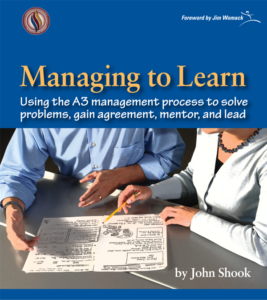
This learning experience is based on the tested and proven methodology created for LEI’s popular Managing to Learn workbook , authored by John Shook , Toyota’s first American manager in Japan, Senior Advisor of the Lean Enterprise Institute, and Chairman of the Lean Global Network.
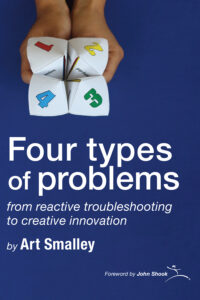
You might also find the book Four Types of Problems helpful in enhancing your problem-solving capabilities. The book explains how most business problems fall into four categories and describes the thought processes, management cadences, and improvement methods t hat will resolve each type.
Time Estimates Per Unit*
*Actual times may vary.
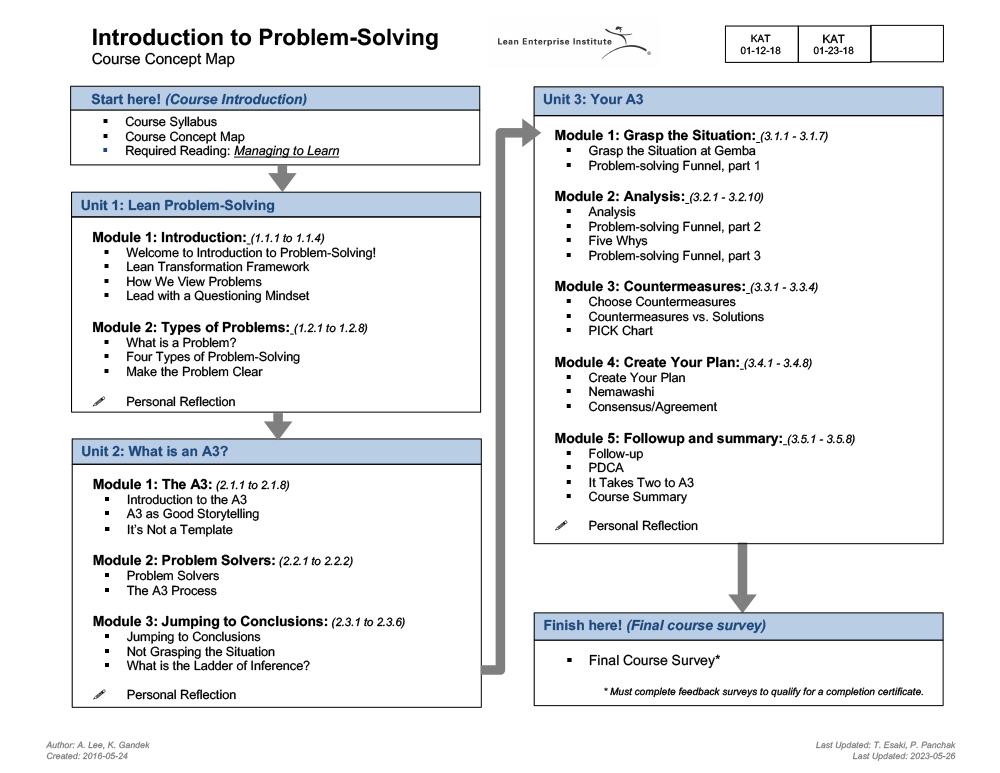
Download the Intro to Problem-Solving Concept Map and share it with your manager.

Senior Advisor, Lean Enterprise Institute
John Shook learned about lean management while working for Toyota for 11 years in Japan and the U.S., helping it transfer production, engineering, and management systems from Japan to NUMMI and other operations around the world. While at Toyota’s headquarters, he became the company’s first American kacho (manager) in Japan. In the U.S., Shook joined […]
Need to level set your team’s lean knowledge and skills? Choose the Lean Fundamentals Enterprise Subscription and gain unlimited access for everyone in your organization to three foundational lean learning experiences for three months.
Lean Fundamentals Bundle
Hear what our customers are saying:.
This training covers what other root cause training does not: The social-technical system which is equally important to using problem solving tools when handling a problem. Problem definition is where most teams fall short. This training covers that well with excellent application examples. Definitely worth taking!
—Christy Leite
This presentation was very helpful to learn more about the A3 process of problem solving.
—Joseph Savey
I thought that this was great not just for a leader but for those who have to work mostly alone and the job involves few leaders. In other words the way it teaches us to think is a great concept for those working under others, can be an impressive show of capabilities.
— Melissa Davis
Related Events
September 06, 2024 | Coach-Led Online Course
Hoshin Kanri
September 11, 2024 | Plant City, Florida and Gainesville, Florida
Lean Warehousing and Distribution Operations
September 16, 2024 | Coach-Led Online Course
Key Concepts of Lean Management
Subscribe to get the very best of lean thinking delivered right to your inbox, privacy overview.
Free Excel A3 Templates: Process, Problem-Solving, and Strategy
By Lulu Richter | July 29, 2024
- Share on Facebook
- Share on LinkedIn
Link copied
Below, you’ll find the most effective A3 templates in Excel for structured problem-solving and continuous improvement.
Included in this article, you’ll find the following:
- A3 status report template
- A3 strategic planning template
- Lean A3 DMAIC template
- A3 action plan template
Excel A3 Problem-Solving Template
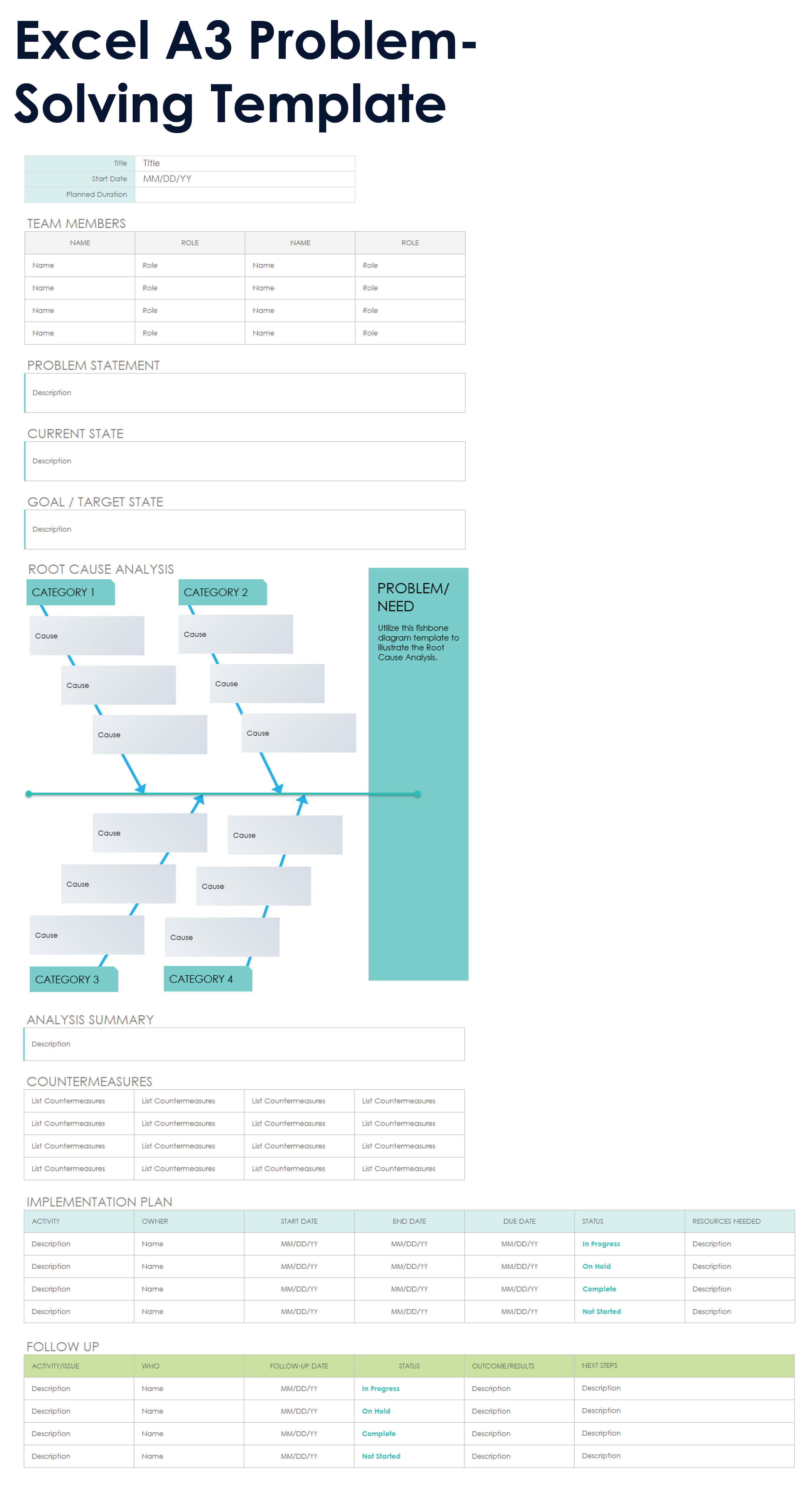
Download the A3 Problem-Solving Template for Excel
When to Use This Template: This template is akin to Toyota's Lean manufacturing-related A3 reports, which follow the Japanese business philosophy of Kaizen, or continuous improvement. Use this template to address a specific problem or to identify opportunities for continuous, incremental improvements.
Notable Template Features: This template provides sections for describing a problem, its current and target states, its planned countermeasures, and an implementation plan. The template combines preformatted tables with blank space for adding visual charts and other documentation. A fillable fishbone diagram aids in root cause analysis .
Excel A3 Proposal Template
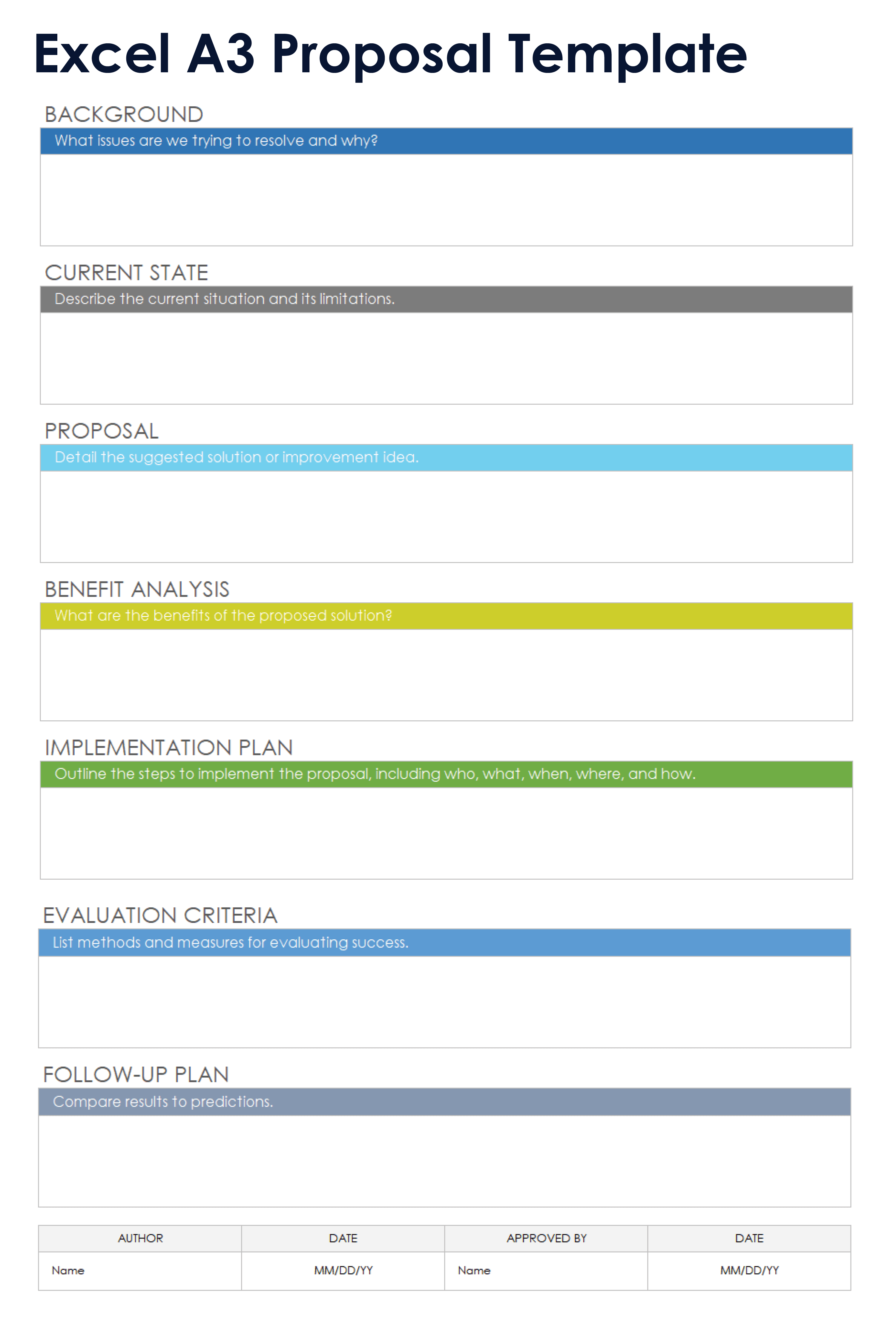
Download the A3 Proposal Template for Excel
When to Use This Template: Choose this A3 template when proposing a new project, process change, or initiative.
Notable Template Features: This template covers the background, current situation, recommendations, implementation plan, and evaluation criteria to help you articulate the need for change and the expected outcomes.
Excel A3 Status Report Template
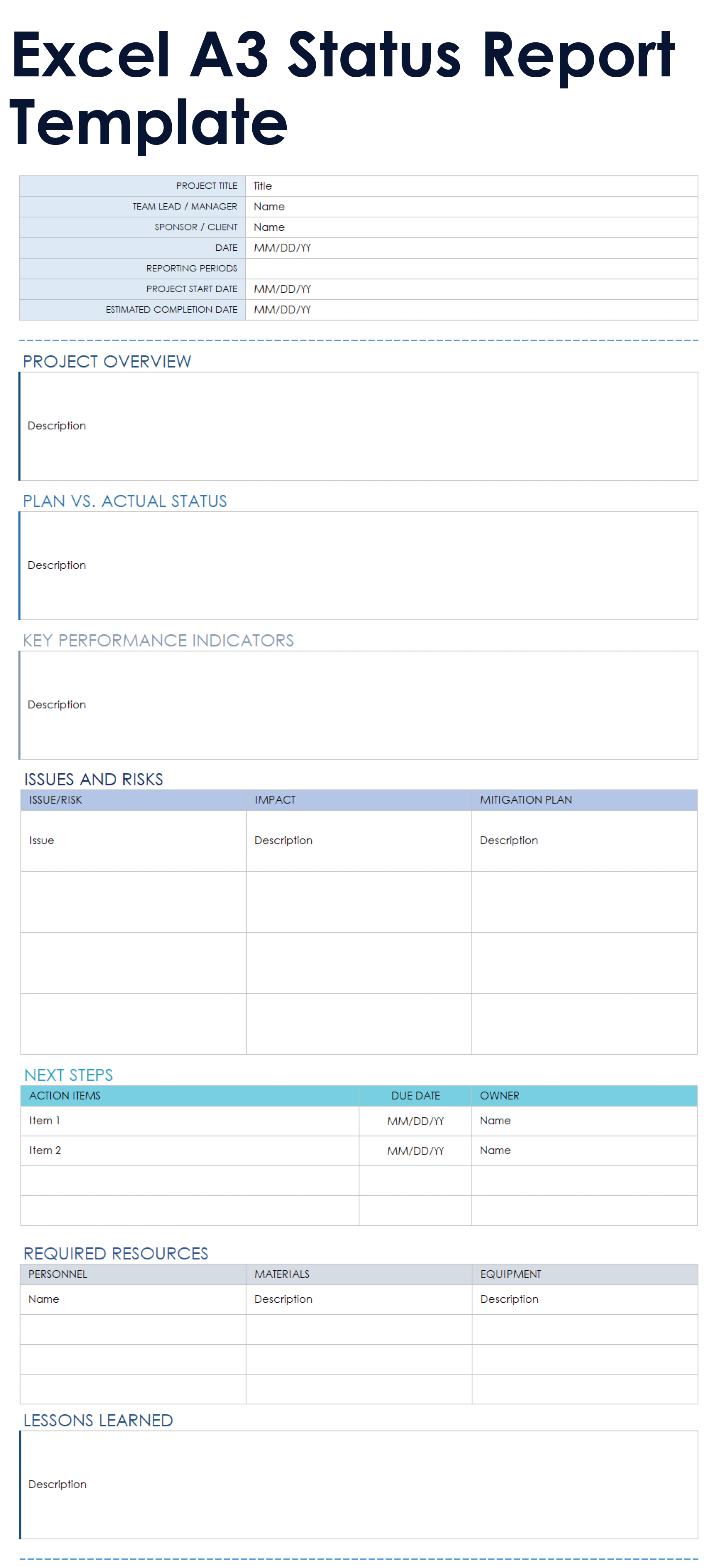
Download the A3 Status Report Template for Excel
When to Use This Template: Use this A3 status report template for periodic updates on ongoing projects or initiatives in order to keep stakeholders informed and engaged.
Notable Template Features: This template allows you to add visuals and tables, so you can document issues and risks, required resources, and next steps. Create a summary report of the current status, metrics, accomplishments, challenges, and lessons learned.
Excel A3 Strategic Planning Template

Download the A3 Strategic Planning Template for Excel
When to Use This Template: Use this A3 strategic planning template to align your organizational strategy with actionable plans, focusing on long-term goals.
Notable Template Features: With a layout similar to a business model canvas , this template supports higher-level planning, with sections for current state and gap analysis, strategic initiatives, action plans, and follow-up. Insert your own visuals to illustrate your analysis and create a comprehensive A3 report.
Excel A3 DMAIC Project Template
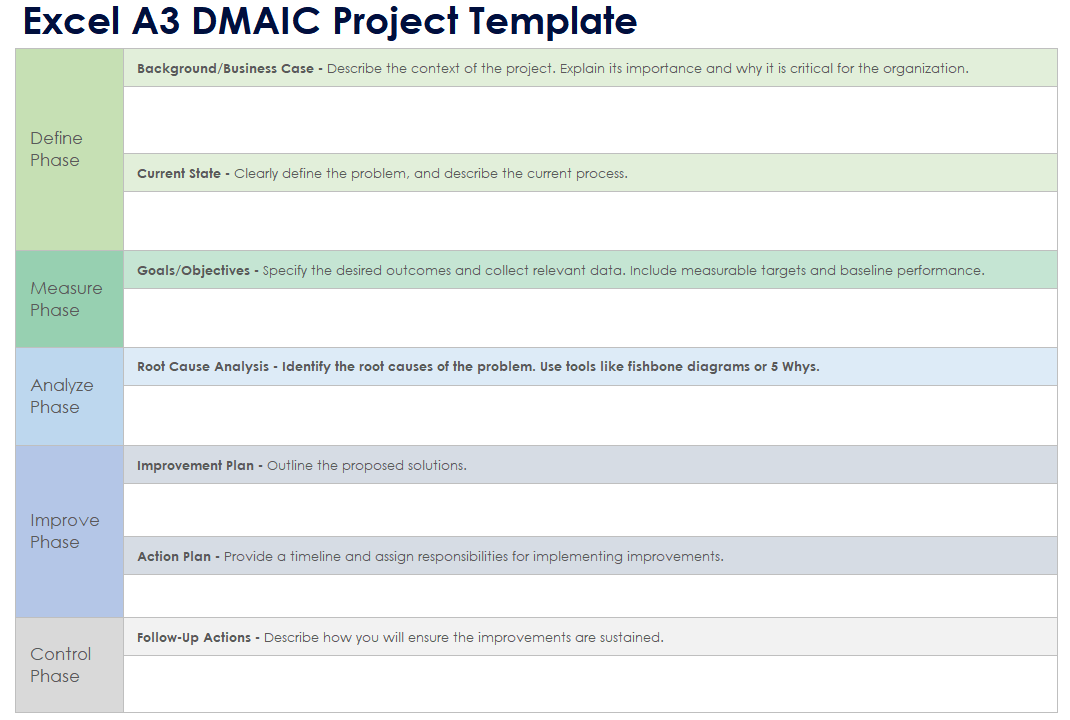
Download the A3 DMAIC Project Template for Excel
When to Use This Template: This A3 template is designed for Six Sigma projects that utilize the DMAIC methodology to improve processes and solve problems.
Notable Template Features: This template is organized around the five DMAIC phases: define, measure, analyze, improve, and control. The template walks users through each stage of process improvement, from defining the problem statement and objectives to analyzing the root cause, proposing solutions, and pursuing follow-up measures.
Use one of these templates to write a problem statement .
Excel Lean A3 DMAIC Template

Download the Lean A3 DMAIC Template for Excel
When to Use This Template: Use this Lean A3 DMAIC template for complex process improvements , projects involving multiple departments or teams, long-term projects, and data-driven initiatives requiring meticulous documentation and tracking.
Notable Template Features: This template combines an A3 DMAIC report with a Gantt chart, so you can visualize the timeline, track progress, and manage dependencies and milestones across the DMAIC project phases. The A3 report includes planned start and end dates for each DMAIC phase, as well as space for visual elements such as process maps, data collection plans, root cause analysis, and other supporting charts and data.
Excel A3 Action Plan Template

Download the A3 Action Plan Template for Excel
When to Use This Template: When implementing actions or projects to reach shorter-term goals, choose this tactical A3 action plan to outline and manage the necessary steps.
Notable Template Features: This template offers a simple layout for adding detailed steps, timelines, responsibilities, and resources, so you can achieve a particular objective. Sections include background information, measurable targets, an action plan, and an evaluation of outcomes. The action plan allows you to manage risk by providing strategies for mitigating potential obstacles.
Improve Process and Problem-Solving with A3 Templates from Smartsheet
Empower your people to go above and beyond with a flexible platform designed to match the needs of your team — and adapt as those needs change.
The Smartsheet platform makes it easy to plan, capture, manage, and report on work from anywhere, helping your team be more effective and get more done. Report on key metrics and get real-time visibility into work as it happens with roll-up reports, dashboards, and automated workflows built to keep your team connected and informed.
When teams have clarity into the work getting done, there’s no telling how much more they can accomplish in the same amount of time. Try Smartsheet for free, today.
Discover why over 90% of Fortune 100 companies trust Smartsheet to get work done.

IMAGES
COMMENTS
Learn the four types of problems and explore the process of lean problem solving to overcome obstacles and improve work processes.
And one that the utility now incorporates into everyone's performance-development plans, so that frontline staff and managers are recognized for solving problems and leaders are recognized for building people's problem-solving capabilities.
These ten simple yet powerful leadership principles developed by Isao Yoshino provide wise guidance for any lean practitioner seeking a path of learning and improvement.
It is realistic and possible to develop lean leaders at all levels given time, persistence, and the dirty word patience. The starting point is to take developing leadership seriously and recognize that short training courses or workshops or coaching leader standard work for a short time will not fundamentally change how your leaders think and act.
DMAIC is the problem-solving approach that drives Lean Six Sigma. DMAIC is a five-phase method (Define, Measure, Analyze, Improve and Control) used for improving existing process problems with unknown causes.
At the heart of lean leadership lies a relentless pursuit of problem-solving excellence. Lean leaders must equip their teams with the necessary tools and techniques to identify, analyze, and address the root causes of inefficiencies and waste.
Lean leadership is an approach rooted in the principles of Lean methodology. At its core, it aims to reduce wasteful processes, streamline operations, and consistently improve organizational performance. A Lean leader is not just a manager but a catalyst for positive change within their team or business.
Gain motivation to learn HOW to put lean thinking into practice as an individual, team-member, and leader. Ground improvement efforts, problem-solving, and people development in the work.
Problem-solving stands as a fundamental skill, crucial in navigating the complexities of both everyday life and professional environments. Far from merely providing quick fixes, it entails a comprehensive process involving the identification, analysis, and resolution of issues. This multifaceted approach requires an understanding of the problem's nature, the exploration of its various ...
Problem-solving in leadership is a multi-faceted competency that requires conceptual thinking, planning, creativity, and collaboration. Leaders must learn to facilitate collaborative problem-solving instead of being solitary master problem-solvers. The right approach to problem-solving in leadership involves the following: Identifying the root ...
Problem solving based on the scientific approach is the essence of lean thinking, and developing all members of the team to become problem solvers should be the main task of a lean leader.
Unlock the secrets to unstoppable business growth with our expert guide on the top 5 problem-solving strategies essential for every leader. Learn how to skillfully tackle challenges, make informed decisions, and drive your company towards unparalleled success.
Designing a Lean Problem-Solving System with Purpose. Leaders must be system architects, taking responsibility and ownership. The following is an excerpt from People Solve Problems: the Power of Every Person, Every Day, Every Problem (2021: Old Dutch Group), the latest book by IndustryWeek lean leadership contributor Jamie Flinchbaugh.
Building a problem-solving culture that lasts Organizations cannot improve unless they consistently seek out and solve their problems. For most, that means undertaking a profound cultural change— which must begin from the top.
Trusting that people can do a good job attacking and solving Type 1 and 2 problems creates a strong bond with them and encourages the entire organization to embrace the kaizen spirit. Coaching and supporting people in their problem-solving activities is the ultimate form of respect.
What is the Lean Transformation Framework? The Lean Transformation Framework is a proven, systematic approach to resolving problems at every level of the enterprise, from executive-level strategy to frontline operations. Whether you lead an established organization or a startup, you can use the Framework to address any troubling issue by ...
The seven-step " root cause " problem solving process is a logical, commonsense method to solve any type of problem. It provides a road map to help everyone solve problems during the improvement journey. It suggests what materials and information are needed to resolve an emergent issue. And it provides a record of the decision making process. If the solution we select does not bring the ...
Build a foundational understanding of problem types and problem solvingIdentify the four types of problems. Resolve business challenges by using scientific method, PDCA-based problem solving. Apply A3 thinking to solve problems. Clearly define problems, beginning with grasping the situation at gemba. Learn to break down vague problems to ...
Objectives To investigate the relationship between lean adoption and problem-solving behaviour in nursing teams, and to explore the practices of lean leaders on nursing wards to reveal how they can stimulate second-order problem-solving within their teams. Design A mixed-methods retrospective multiple case study using semistructured interviews. Interview data were used to assess the level of ...
As lean matures, nursing teams reach a higher level of second-order problem-solving. In later stages, lean leaders increasingly relinquish responsibility by developing self-managing teams.
Learn how high emotional intelligence can enhance problem solving and team dynamics for effective leadership.
The second shift, digging for root causes of problems rather than looking for quick fixes, recognizes that when problems aren't fully solved they inevitably return—creating still more waste that the organization could have avoided. But the discipline and time required for root-cause problem solving are demanding for busy leaders, who may be tempted to redirect the effort toward taking ...
Let's explore the concept of resilient leadership, its significance in the professional realm and how you can develop and embody resilient leadership qualities.
The A3 'problem' (a gap, in this case, between the intended purpose and actual usage) echoes the broader challenge facing widespread adoption of any proven TPS methodology: moving from lean tools to lean management, according to Jim Womack. As he notes, "Tools—for process analysis and for management—are wonderful things.
Empowering your team with the freedom to operate autonomously can be a winning strategy for business continuity and success.
This training will enhance your understanding of team dynamics in problem-solving and increase group cohesion, effectiveness, and team building. Objectives: Learn more about Kirton's Adaption-Innovation Theory; Explore your own problem-solving style; Brainstorm how this can help you in your workplace and even in your personal life.
While building a more diverse driver workforce is crucial, the conversation about diversity in the trucking industry should also focus on leadership.
Learn a proven, systematic approach to resolving business and work process problems, including how to overcome the shortcomings of most problem-solving efforts: not understanding the situation and jumping to conclusions.
Download A3 templates in project and report formats for problem-solving, proposals, status reports, strategic planning, and DMAIC.